Paul van Yperen's Blog, page 364
November 14, 2015
Ellen Terry
English stage actress Dame Ellen Terry (1847-1928) was the leading lady of legendary stage actor Henry Irving and the Queen of Britain’s stage of the Victorian era. She later starred in several silent films. Her warmth, gentleness, and beauty made her one of the most popular actresses in Britain and the U.S., and she continued to act until 1925. Among the members of her famous family is her great nephew, John Gielgud.
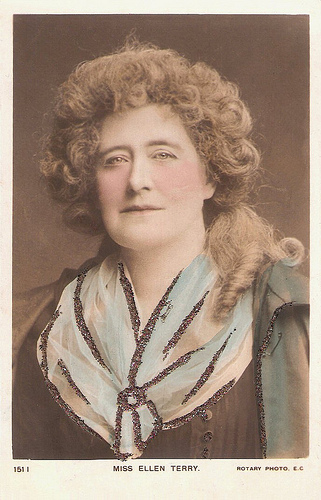
British postcard by Rotary Photo, no. 151 I.
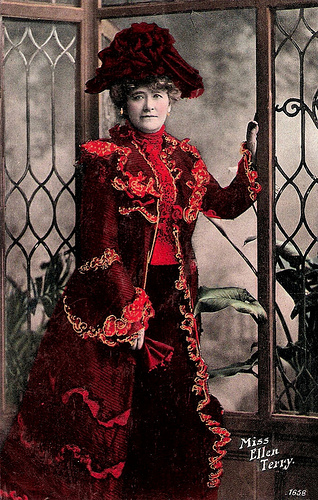
British postcard by The Rapid Photo printing Co. Ltd., London, no. 1658.
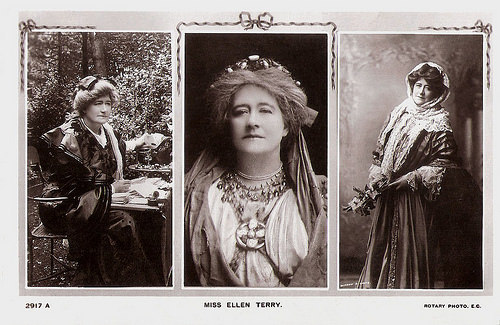
British postcard by Rotary Photo, no. 2917 A. Photo right: Window & Grove.
A Family of Actors
Alice Ellen Terry was born in Coventry, England in 1847 into a family of actors. Her parents, Benjamin Terry of Irish descent, and Sarah Terry (née Ballard), of Scottish ancestry, were comic actors in a touring company based in Portsmouth, and had eleven children. At least five of them became actors: Kate, Ellen, Marion, Florence and Fred. Two other children, George and Charles, were connected with theater management. Kate's grandson, Sir John Gielgud, became one of the 20th century's most respected actors.
Ellen Terry's first appearance on stage came at the age of eight, when she appeared as Mamillius the child under the direction of Charles Kean in William Shakespeare’s A Winter's Tale at the Princess Theater in London on 28 April 1856, with Queen Victoria in attendance. She continued to appear on stage as a teen, in London and on tour.
At sixteen she married the famous painter George Frederick Watts, thirty years her senior, and she retired from the stage. Watts's famous portraits of Terry, including Choosing and Ophelia, were more successful than their domestic affairs, however, and they separated within a year. She briefly returned to acting and in 1867, she first played opposite Henry Irving in the title roles of Katherine and Petruchio, David Garrick's one-act version of The Taming of the Shrew.
Then she began a relationship with the progressive architect-designer and essayist Edward William Godwin. With him she retreated to a house in Hertfordshire, retiring for six years from acting. They could not marry, as Terry was still married to Watts and did not finalize a divorce until 1877 – then a scandalous situation. With Godwin she had a daughter, Edith Ailsa Geraldine Craig, in 1869 and a son, Edward Gordon Craig, in 1872. She returned to acting in 1874, separating from Godwin in 1875.
In 1875, Terry gave an acclaimed performance as Portia in The Merchant of Venice at the Prince of Wales's Theatre. Oscar Wilde wrote a sonnet, upon seeing her in this role: "No woman Veronese looked upon / Was half so fair as thou whom I behold." She recreated this role many times in her career until her last appearance as Portia at London's Old Vic Theatre in 1917. Terry married again, in November 1877, to actor/journalist Charles Clavering Wardell Kelly, but they separated in 1881.
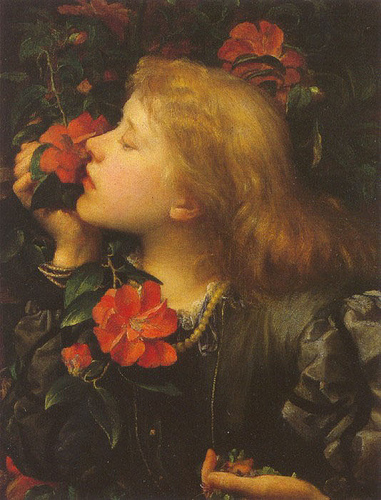
George Frederick Watts, Choosing, 1864. Source: Freeparking@Flickr.
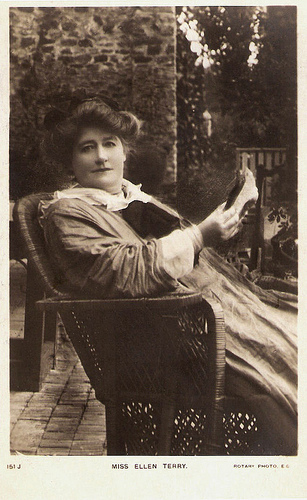
British postcard by Rotary Photo, nr. 151 J. Sent by mail in 1905.
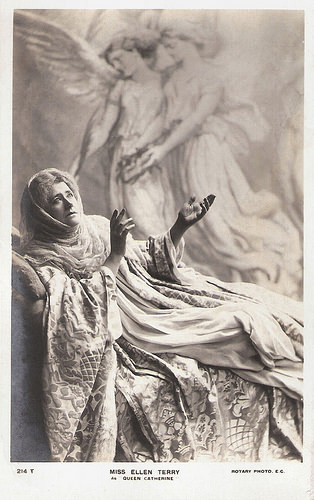
British postcard by Rotary Photo, no. 214 T. Photo: publicity still for a stage production of Henry VIII (1892-).
A Star-studded Gala Performance
In 1878, the 30 years-old Ellen Terry joined Henry Irving 's company at the Lyceum Theatre as its leading lady, at a generous salary, beginning with Ophelia opposite Irving's Hamlet. Her association with Irving was to become the most successful of her career, and over the next two decades she played many of the great Shakespearean heroines, including Ophelia, Lady Macbeth, Viola, Queen Katherine, Juliet, and Cordelia.
Two of her most famous roles were Portia in The Merchant of Venice, which ran for an unusual 250 nights in 1879, and perhaps most notably Beatrice in Much Ado about Nothing, a role she first performed at the Lyceum in 1882 and later revived in 1884, 1891, and 1893. She and Irving also toured with great success in America and Britain. They reigned together the British theatre in the Shakespeare canon and in Alfred Tennyson, Edward George Bulwer-Lytton, Charles Reade, Victorien Sardou, and plays by other contemporary playwrights until they left the Lyceum in 1902.
In 1903, she formed a new theatrical company, taking over management of the Imperial Theatre with her son. Here she had complete artistic control and could choose the works in which she would appear. She focused on the plays of George Bernard Shaw and Henrik Ibsen. In the 1890s, Terry had struck up a friendship, and conducted a famous correspondence, with Shaw. Theatre management turned out to be a financial failure for Terry, who had hoped the venture would showcase the set design and directing talents of her son and the costume designs of her daughter. She then toured and later also lectured.
On 12 June 1906, after 50 years on the stage, a star-studded gala performance was held at the Drury Lane Theatre for Terry's benefit and to celebrate her golden jubilee, at which Enrico Caruso sang, Eleanora Duse , Mrs. Patrick Campbell , Lillie Langtry, Herbert Beerbohm Tree , Nellie Melba, and more than twenty members of Terry's family performed in an act of Much Ado about Nothing with her, among other performances. The benefit raised £6000 for Terry.
In 1907 she toured America in Shaw’s Captain Brassbound's Conversion under the direction of Charles Frohman. During that tour, she married her co-star, American actor James Carew, who had appeared with her at the Court Theatre. She was thirty years older than Carew. Terry's acting career continued strongly, but her marriage broke up after only two years.
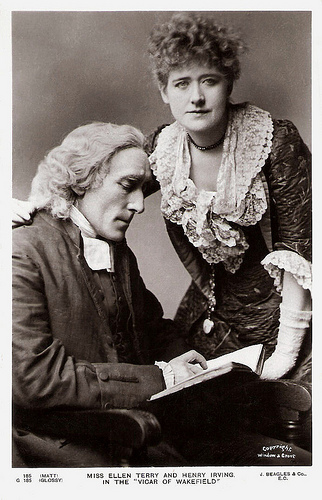
British postcard by J. Beagles & Co., London, no. 185. Sent by mail in 1905. Photo: Window & Grove. Publicity still for the stage play The Vicar of Wakefield with Henry Irving .
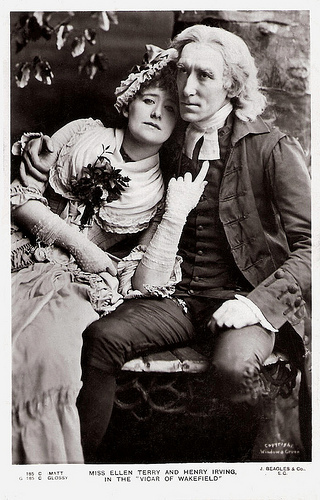
British postcard by J. Beagles & Co., London, no. 185 C. Sent by mail in 1907. Photo: Window & Grove. Publicity still for the stage play The Vicar of Wakefield with Henry Irving .
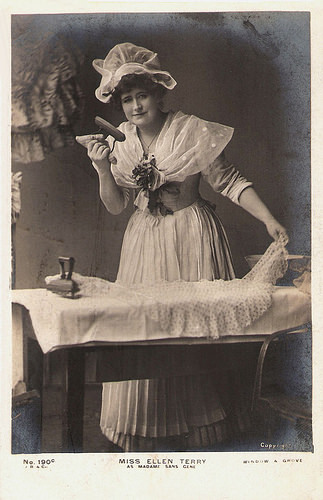
British postcard by J.B. & Co, 190C. Photo: Window & Grove. Ellen Terry as Madame Sans Gêne in the stage play Madame Sans Gêne (1897) by Victorien Sardou and Emile Moreau.
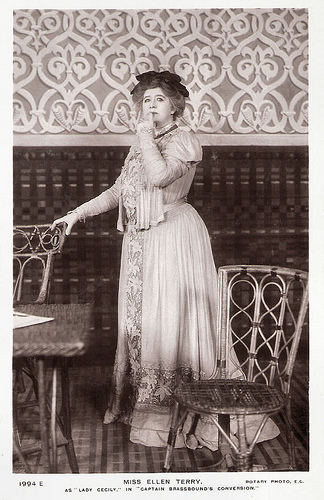
British postcard by Rotary Photo, no. 1994 E. Publicity photo for the stage play Captain Brassbound's Conversion (1906) by George Bernard Shaw.
Her Greatest Performance
In 1911, Ellen Terry recorded scenes from five Shakespeare roles for the Victor Talking Machine Company, the only known recordings of her voice. During World War I she performed in many war benefits. In 1916, she appeared in her first film as Julia Lovelace in Her Greatest Performance (Fred Paul, 1917) and continued to act in London and on tour.
She made a few more films through 1922, including The Invasion of Britain (Herbert Brenon, 1918), Victory and Peace (Herbert Brenon, 1918) with Matheson Lang , Pillars of Society (Rex Wilson, 1920), Potter's Clay (H. Grenville-Taylor, Douglas Payne, 1922), and The Bohemian Girl (Harley Knoles, 1922) as Buda the nursemaid, with Ivor Novello and Gladys Cooper .
She continued to lecture on Shakespeare throughout England and North America. She also gave scenes from Shakespeare plays in music halls under the management of Oswald Stoll. Her last fully staged role was as the Nurse in Romeo and Juliet at the Lyric Theatre in 1919. In 1920 she retired from the stage and in 1922 from film, although she returned to play Susan Wildersham in Walter de la Mare's fairy play Crossings, in November 1925 at the Lyric Theatre, Hammersmith.
In 1922, St. Andrews University conferred an honorary LLD upon Terry, and in 1925 she was made a Dame Grand Cross of the Order of the British Empire, only the second actress to be so honoured. In her last years, she gradually lost her eyesight and suffered from senility. Stephen Coleridge anonymously published Terry's second autobiography, The Heart of Ellen Terry in 1928.
Ellen Terry died of a cerebral haemorrhage at her home at Smallhythe Place in Kent, England, at age 81. Her career had lasted nearly seven decades. After her death, her correspondence with G. B. Shaw was published.
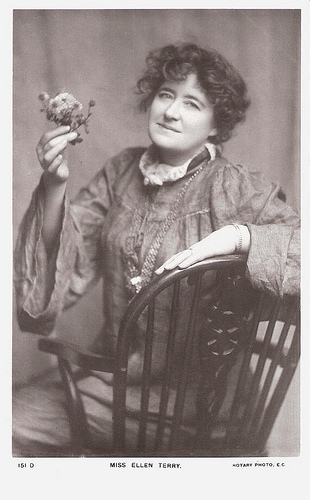
British postcard in the Rotary Photographic Series, no. 151D.
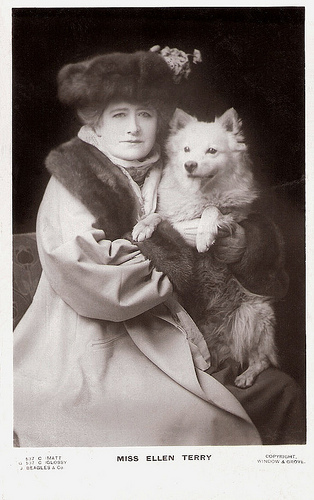
British postcard by J. Beagles & Co., London, no. 537 C. Sent by mail in 1906. Photo: Window & Grove.
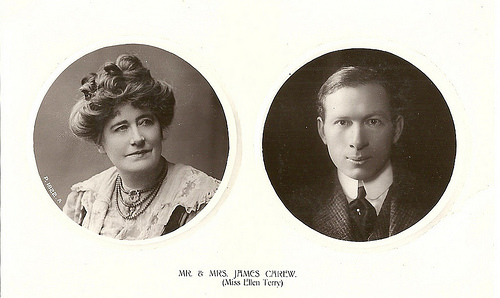
British postcard by Rotary Photo E.c., no. P.1822.a. With James Carew.
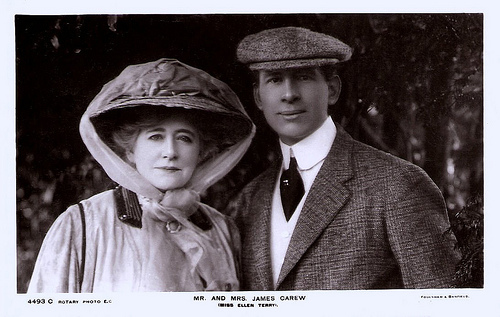
British postcard by Rotary Photo, no. 4493 G. With James Carew.
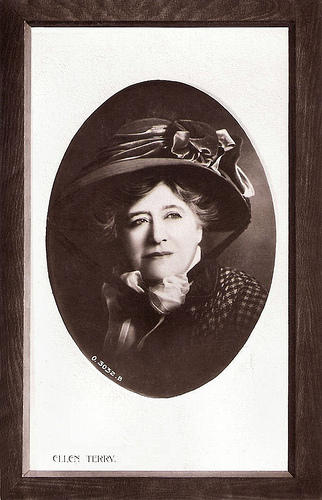
British postcard by Rotary Photo in the Opalette Series, no. 0.3032.B.
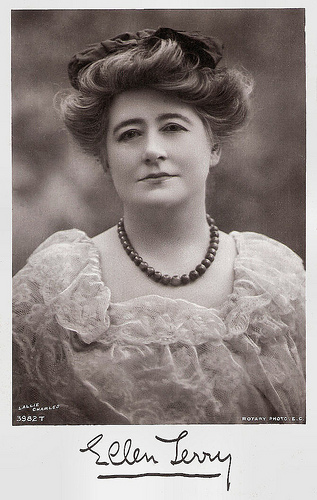
British postcard in the Rotary Photographic Series, no. 3982 T. Sent by mail in 1909. Photo: Lallie Charles.
Sources: Roger Manvell (Encyclopaedia Britannica), Gale Encyclopedia of Biography, Wikipedia and .

British postcard by Rotary Photo, no. 151 I.

British postcard by The Rapid Photo printing Co. Ltd., London, no. 1658.

British postcard by Rotary Photo, no. 2917 A. Photo right: Window & Grove.
A Family of Actors
Alice Ellen Terry was born in Coventry, England in 1847 into a family of actors. Her parents, Benjamin Terry of Irish descent, and Sarah Terry (née Ballard), of Scottish ancestry, were comic actors in a touring company based in Portsmouth, and had eleven children. At least five of them became actors: Kate, Ellen, Marion, Florence and Fred. Two other children, George and Charles, were connected with theater management. Kate's grandson, Sir John Gielgud, became one of the 20th century's most respected actors.
Ellen Terry's first appearance on stage came at the age of eight, when she appeared as Mamillius the child under the direction of Charles Kean in William Shakespeare’s A Winter's Tale at the Princess Theater in London on 28 April 1856, with Queen Victoria in attendance. She continued to appear on stage as a teen, in London and on tour.
At sixteen she married the famous painter George Frederick Watts, thirty years her senior, and she retired from the stage. Watts's famous portraits of Terry, including Choosing and Ophelia, were more successful than their domestic affairs, however, and they separated within a year. She briefly returned to acting and in 1867, she first played opposite Henry Irving in the title roles of Katherine and Petruchio, David Garrick's one-act version of The Taming of the Shrew.
Then she began a relationship with the progressive architect-designer and essayist Edward William Godwin. With him she retreated to a house in Hertfordshire, retiring for six years from acting. They could not marry, as Terry was still married to Watts and did not finalize a divorce until 1877 – then a scandalous situation. With Godwin she had a daughter, Edith Ailsa Geraldine Craig, in 1869 and a son, Edward Gordon Craig, in 1872. She returned to acting in 1874, separating from Godwin in 1875.
In 1875, Terry gave an acclaimed performance as Portia in The Merchant of Venice at the Prince of Wales's Theatre. Oscar Wilde wrote a sonnet, upon seeing her in this role: "No woman Veronese looked upon / Was half so fair as thou whom I behold." She recreated this role many times in her career until her last appearance as Portia at London's Old Vic Theatre in 1917. Terry married again, in November 1877, to actor/journalist Charles Clavering Wardell Kelly, but they separated in 1881.

George Frederick Watts, Choosing, 1864. Source: Freeparking@Flickr.

British postcard by Rotary Photo, nr. 151 J. Sent by mail in 1905.

British postcard by Rotary Photo, no. 214 T. Photo: publicity still for a stage production of Henry VIII (1892-).
A Star-studded Gala Performance
In 1878, the 30 years-old Ellen Terry joined Henry Irving 's company at the Lyceum Theatre as its leading lady, at a generous salary, beginning with Ophelia opposite Irving's Hamlet. Her association with Irving was to become the most successful of her career, and over the next two decades she played many of the great Shakespearean heroines, including Ophelia, Lady Macbeth, Viola, Queen Katherine, Juliet, and Cordelia.
Two of her most famous roles were Portia in The Merchant of Venice, which ran for an unusual 250 nights in 1879, and perhaps most notably Beatrice in Much Ado about Nothing, a role she first performed at the Lyceum in 1882 and later revived in 1884, 1891, and 1893. She and Irving also toured with great success in America and Britain. They reigned together the British theatre in the Shakespeare canon and in Alfred Tennyson, Edward George Bulwer-Lytton, Charles Reade, Victorien Sardou, and plays by other contemporary playwrights until they left the Lyceum in 1902.
In 1903, she formed a new theatrical company, taking over management of the Imperial Theatre with her son. Here she had complete artistic control and could choose the works in which she would appear. She focused on the plays of George Bernard Shaw and Henrik Ibsen. In the 1890s, Terry had struck up a friendship, and conducted a famous correspondence, with Shaw. Theatre management turned out to be a financial failure for Terry, who had hoped the venture would showcase the set design and directing talents of her son and the costume designs of her daughter. She then toured and later also lectured.
On 12 June 1906, after 50 years on the stage, a star-studded gala performance was held at the Drury Lane Theatre for Terry's benefit and to celebrate her golden jubilee, at which Enrico Caruso sang, Eleanora Duse , Mrs. Patrick Campbell , Lillie Langtry, Herbert Beerbohm Tree , Nellie Melba, and more than twenty members of Terry's family performed in an act of Much Ado about Nothing with her, among other performances. The benefit raised £6000 for Terry.
In 1907 she toured America in Shaw’s Captain Brassbound's Conversion under the direction of Charles Frohman. During that tour, she married her co-star, American actor James Carew, who had appeared with her at the Court Theatre. She was thirty years older than Carew. Terry's acting career continued strongly, but her marriage broke up after only two years.

British postcard by J. Beagles & Co., London, no. 185. Sent by mail in 1905. Photo: Window & Grove. Publicity still for the stage play The Vicar of Wakefield with Henry Irving .

British postcard by J. Beagles & Co., London, no. 185 C. Sent by mail in 1907. Photo: Window & Grove. Publicity still for the stage play The Vicar of Wakefield with Henry Irving .

British postcard by J.B. & Co, 190C. Photo: Window & Grove. Ellen Terry as Madame Sans Gêne in the stage play Madame Sans Gêne (1897) by Victorien Sardou and Emile Moreau.

British postcard by Rotary Photo, no. 1994 E. Publicity photo for the stage play Captain Brassbound's Conversion (1906) by George Bernard Shaw.
Her Greatest Performance
In 1911, Ellen Terry recorded scenes from five Shakespeare roles for the Victor Talking Machine Company, the only known recordings of her voice. During World War I she performed in many war benefits. In 1916, she appeared in her first film as Julia Lovelace in Her Greatest Performance (Fred Paul, 1917) and continued to act in London and on tour.
She made a few more films through 1922, including The Invasion of Britain (Herbert Brenon, 1918), Victory and Peace (Herbert Brenon, 1918) with Matheson Lang , Pillars of Society (Rex Wilson, 1920), Potter's Clay (H. Grenville-Taylor, Douglas Payne, 1922), and The Bohemian Girl (Harley Knoles, 1922) as Buda the nursemaid, with Ivor Novello and Gladys Cooper .
She continued to lecture on Shakespeare throughout England and North America. She also gave scenes from Shakespeare plays in music halls under the management of Oswald Stoll. Her last fully staged role was as the Nurse in Romeo and Juliet at the Lyric Theatre in 1919. In 1920 she retired from the stage and in 1922 from film, although she returned to play Susan Wildersham in Walter de la Mare's fairy play Crossings, in November 1925 at the Lyric Theatre, Hammersmith.
In 1922, St. Andrews University conferred an honorary LLD upon Terry, and in 1925 she was made a Dame Grand Cross of the Order of the British Empire, only the second actress to be so honoured. In her last years, she gradually lost her eyesight and suffered from senility. Stephen Coleridge anonymously published Terry's second autobiography, The Heart of Ellen Terry in 1928.
Ellen Terry died of a cerebral haemorrhage at her home at Smallhythe Place in Kent, England, at age 81. Her career had lasted nearly seven decades. After her death, her correspondence with G. B. Shaw was published.

British postcard in the Rotary Photographic Series, no. 151D.

British postcard by J. Beagles & Co., London, no. 537 C. Sent by mail in 1906. Photo: Window & Grove.

British postcard by Rotary Photo E.c., no. P.1822.a. With James Carew.

British postcard by Rotary Photo, no. 4493 G. With James Carew.

British postcard by Rotary Photo in the Opalette Series, no. 0.3032.B.

British postcard in the Rotary Photographic Series, no. 3982 T. Sent by mail in 1909. Photo: Lallie Charles.
Sources: Roger Manvell (Encyclopaedia Britannica), Gale Encyclopedia of Biography, Wikipedia and .
Published on November 14, 2015 22:00
November 13, 2015
Imported from the USA: John Saxon
American actor John Saxon (1935) worked on over 200 film and TV projects during the span of seven decades. Saxon appeared in many Italian films, mainly in Spaghetti Westerns.
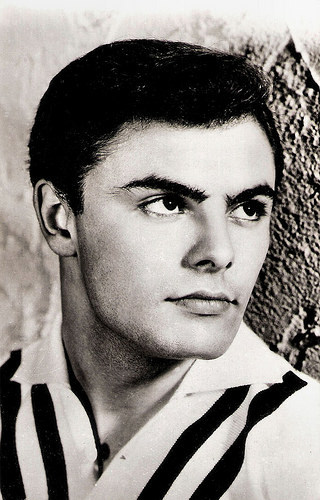
Yugoslavian postcard by Izrada Nas Glas, Smederevo, no. 163.
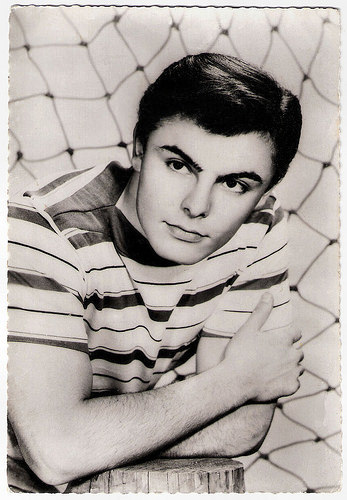
Yugoslavian postcard by IZK, no. 2181.
Running Wild
John Saxon was born Carmine Orrico in Brooklyn, New York, in 1935. He is the son of immigrants from Calabria, Italy.
He studied acting with famous acting coach Stella Adler. Wikipedia : "According to Robert Hofler's 2005 biography, The Man Who Invented Rock Hudson: The Pretty Boys and Dirty Deals of Henry Willson, agent Willson saw Saxon's picture on the cover of a detective magazine and immediately contacted the boy's family in Brooklyn. He brought the 18-year-old Orrico to Hollywood and renamed him Saxon."
He started his Hollywood career as a juvenile delinquent in Running Wild (Abner Biberman, 1955) starring Mamie van Doren.
Thanks to 'hunk' assignments in films like Summer Love (Charles F. Haas, 1958), The Restless Years (Helmut Käutner 1958), and The Reluctant Debutante (Vincente Minnelli, 1958), Saxon was briefly the object of many a teenage crush.
Although he worked in these years with many notable directors including Blake Edwards, John Huston, Frank Borzage, and Otto Preminger, he never developed into a major star.
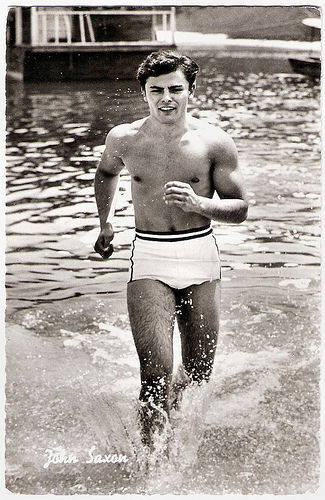
Austrian postcard by Bild und Ton, Wien, no. 503.
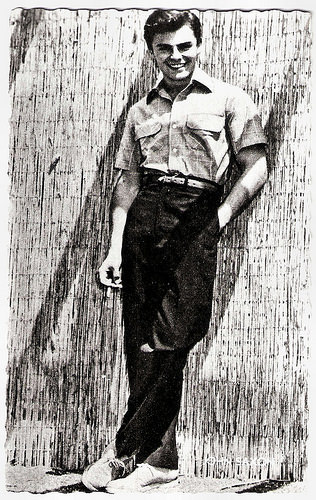
Dutch postcard by Int. Filmpers, Amsterdam, no. 1121.
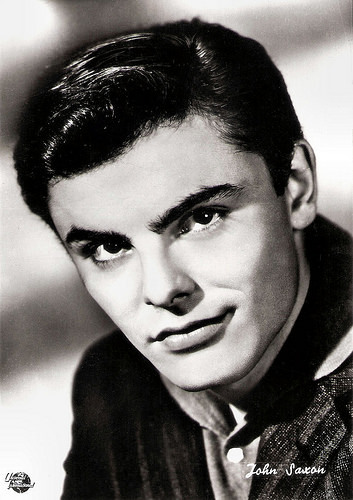
Italian postcard by Bromofoto, Milano, no. 1348. Photo: Universal International.
A Nightmare on Elm Street
John Saxon is now best known for his work in Westerns like Joe Kidd (John Sturges, 1972) starring Clint Eastwood , and horror films, such as the Italian giallo film, La ragazza che sapeva troppo/The Girl Who Knew Too Much (Mario Bava, 1963) with Leticia Roman , and Queen of Blood (Curtis Harrington, 1966) with Basil Rathbone and Dennis Hopper.
Saxon appeared in many Italian films, mainly in Spaghetti Westerns like I tre che sconvolsero il West (Vado, vedo e sparo)/One Dollar Too Many (Enzo G. Castellari, 1968) and such police thrillers as Napoli violenta/Violent Naples (Umberto Lenzi, 1976).
He also co-starred with Bruce Lee and Jim Kelly in the classic Hong Kong martial arts action film Enter the Dragon (Robert Clouse, 1973). Another classic genre film is Wes Craven's A Nightmare on Elm Street (1984) in which he played the heroine's (Nancy Thompson's) father.
Hal Erickson at AllMovie : "Fans could watch Saxon's expertise as an actor increase (and his hairline recede) during his three-year (1969-1972) stint as Dr. Ted Stuart on the NBC television series The Bold Ones. He later appeared as a semiregular on the prime-time TV soaper Dallas. In 1988, John Saxon made his directorial debut with the low-budget feature Death House."
Hopefully, Saxon can be seen soon as a Bounty Hunter in a new Western by Enzo G. Castellari, Keoma Rises, which is announced at IMDb . It has an all-star cast including Bud Spencer , Tomas Milian, Fabio Testi, George Hilton, and Franco Nero as Keoma.
John Saxon was married twice. He has one son, Antonio Saxon, with his former wife Mary Ann Saxon. His current wife is Gloria Martel.
Scene from Rock Pretty Baby! (1956). Source: TaylorHamKid (YouTube).
Italian trailer I tre che sconvolsero il West (Vado, vedo e sparo)/One Dollar Too Many (1968). Source: neverlando74 (YouTube).
Sources: Hal Erickson (AllMovie), (IMDb), Wikipedia and .

Yugoslavian postcard by Izrada Nas Glas, Smederevo, no. 163.

Yugoslavian postcard by IZK, no. 2181.
Running Wild
John Saxon was born Carmine Orrico in Brooklyn, New York, in 1935. He is the son of immigrants from Calabria, Italy.
He studied acting with famous acting coach Stella Adler. Wikipedia : "According to Robert Hofler's 2005 biography, The Man Who Invented Rock Hudson: The Pretty Boys and Dirty Deals of Henry Willson, agent Willson saw Saxon's picture on the cover of a detective magazine and immediately contacted the boy's family in Brooklyn. He brought the 18-year-old Orrico to Hollywood and renamed him Saxon."
He started his Hollywood career as a juvenile delinquent in Running Wild (Abner Biberman, 1955) starring Mamie van Doren.
Thanks to 'hunk' assignments in films like Summer Love (Charles F. Haas, 1958), The Restless Years (Helmut Käutner 1958), and The Reluctant Debutante (Vincente Minnelli, 1958), Saxon was briefly the object of many a teenage crush.
Although he worked in these years with many notable directors including Blake Edwards, John Huston, Frank Borzage, and Otto Preminger, he never developed into a major star.

Austrian postcard by Bild und Ton, Wien, no. 503.

Dutch postcard by Int. Filmpers, Amsterdam, no. 1121.

Italian postcard by Bromofoto, Milano, no. 1348. Photo: Universal International.
A Nightmare on Elm Street
John Saxon is now best known for his work in Westerns like Joe Kidd (John Sturges, 1972) starring Clint Eastwood , and horror films, such as the Italian giallo film, La ragazza che sapeva troppo/The Girl Who Knew Too Much (Mario Bava, 1963) with Leticia Roman , and Queen of Blood (Curtis Harrington, 1966) with Basil Rathbone and Dennis Hopper.
Saxon appeared in many Italian films, mainly in Spaghetti Westerns like I tre che sconvolsero il West (Vado, vedo e sparo)/One Dollar Too Many (Enzo G. Castellari, 1968) and such police thrillers as Napoli violenta/Violent Naples (Umberto Lenzi, 1976).
He also co-starred with Bruce Lee and Jim Kelly in the classic Hong Kong martial arts action film Enter the Dragon (Robert Clouse, 1973). Another classic genre film is Wes Craven's A Nightmare on Elm Street (1984) in which he played the heroine's (Nancy Thompson's) father.
Hal Erickson at AllMovie : "Fans could watch Saxon's expertise as an actor increase (and his hairline recede) during his three-year (1969-1972) stint as Dr. Ted Stuart on the NBC television series The Bold Ones. He later appeared as a semiregular on the prime-time TV soaper Dallas. In 1988, John Saxon made his directorial debut with the low-budget feature Death House."
Hopefully, Saxon can be seen soon as a Bounty Hunter in a new Western by Enzo G. Castellari, Keoma Rises, which is announced at IMDb . It has an all-star cast including Bud Spencer , Tomas Milian, Fabio Testi, George Hilton, and Franco Nero as Keoma.
John Saxon was married twice. He has one son, Antonio Saxon, with his former wife Mary Ann Saxon. His current wife is Gloria Martel.
Scene from Rock Pretty Baby! (1956). Source: TaylorHamKid (YouTube).
Italian trailer I tre che sconvolsero il West (Vado, vedo e sparo)/One Dollar Too Many (1968). Source: neverlando74 (YouTube).
Sources: Hal Erickson (AllMovie), (IMDb), Wikipedia and .
Published on November 13, 2015 22:00
November 12, 2015
EFSP's Dazzling Dozen: new postcards from the collection of Didier Hanson
In September, we posted 24 rare, recently acquired postcards from the collection of Didier Hanson. Didier keeps sending us wonderful scans. So, today we can post again a dazzling dozen of his a-century-old postcards from Germany and Russia. These include postcards of Das Mirakel/The Miracle (Michel Carré, 1912), portraits of the great stage innovators Max Reinhardt and C.S. Stanislavsky, and three cards of Russian silent film diva Vera Karalli.
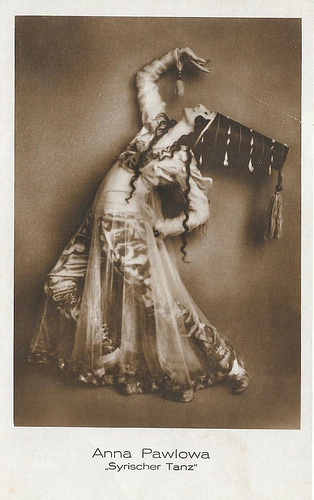
German postcard. Collection: Didier Hanson.
Anna Pavlova (Russian: Анна Павлова; 1881–1931) was a Russian prima ballerina of the late 19th and the early 20th centuries. She was a principal artist of the Imperial Russian Ballet and the Ballets Russes of Sergei Diaghilev. Pavlova is most recognized for the creation of the role The Dying Swan and, with her own company, became the first ballerina to tour ballet around the world.
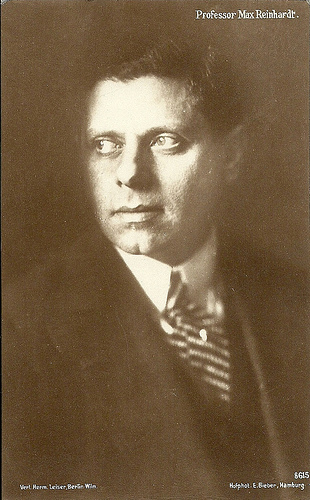
German postcard by Verlag Hermann Leiser, Berlin, no. 8615. Photo: Hofphot. E. Bieber, Hamburg. Collection: Didier Hanson.
German actor-director Max Reinhardt (1873-1943) was one of the great innovators of the theatre. He also directed several films, including Sumurûn (1910) and Das Mirakel (1912). In 1934, he went into exile and made in Hollywood A Midsummer Night's Dream (1935).
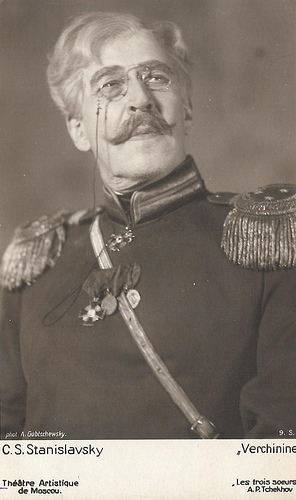
French postcard, no. R 9. S. Photo: A. Gubtschewsky. C.S. Stanislavsky as Verchinine in the stage production of Les trois soeurs/Three Sisters (Anton Chekhov) by Théâtre Artistique de Moscou (Moscow Art Theatre). Collection: Didier Hanson.
Constantin Sergeievich Stanislavsky (Константи́н Серге́евич Станисла́вский) (1863–1938) was a Russian actor and theatre director. The eponymous Stanislavsky method, or simply 'method acting', has had a pervasive influence on the American theatre and cinema, especially in the period after World War II.
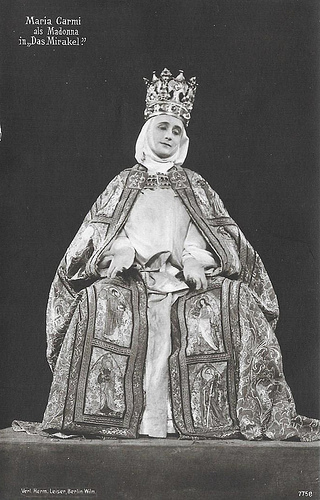
German postcard by Verleih Hermann Leiser, Berlin-Wilmersdorf, no. 7758. Publicity still for Das Mirakel/The Miracle (Michel Carré, 1912). Collection: Didier Hanson.
With her aristocratic air, her severe looks but also her sweet undertones, Italian silent film star and stage actress Maria Carmi (1880-1957) was the cinematic translation of the 19th century Primadonna. Later she became Princess Norina Matchabelli and was co-founder of the perfume company Prince Matchabelli.
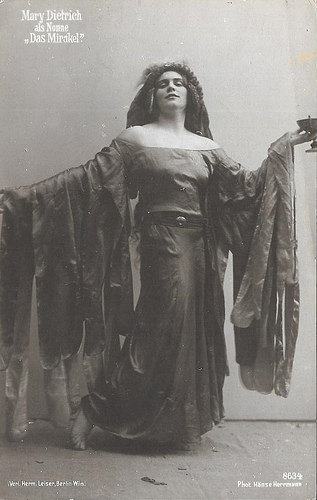
German postcard by Verleih Hermann Leiser, Berlin-Wilmersdorf, no. 8634. Photo: Hänse Hermann. Publicity still for Das Mirakel/The Miracle (Michel Carré, 1912). Collection: Didier Hanson. Mary Dietrich as the nun.
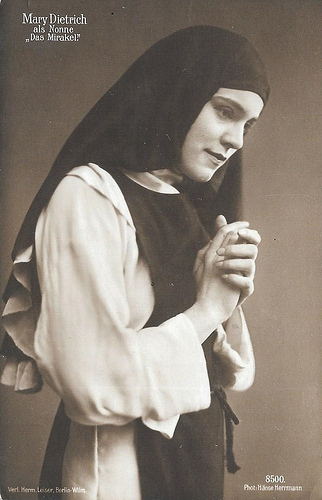
German postcard by Verleih Hermann Leiser, Berlin-Wilmersdorf, no. 8500. Photo: Hänse Hermann. Publicity still for Das Mirakel/The Miracle (Michel Carré, 1912). Collection: Didier Hanson. Mary Dietrich as the nun.
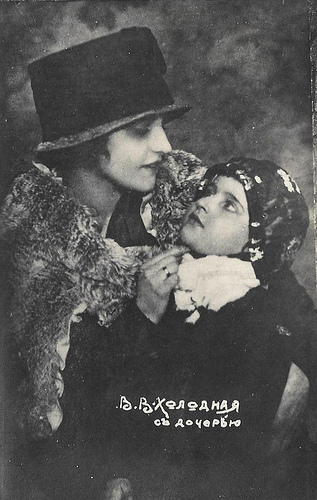
Russian postcard. Collection: Didier Hanson.
Vera Kholodnaya (1893-1919) was the first star of the Russian silent cinema. Only 26, the ‘Queen of Screen’ died of the Spanish flu during the pandemic of 1919. Although she worked only three years for the cinema, she must have made between fifty and hundred short films. The Soviet authorities ordered to destroy many of the Kholodnaya features in 1924, and only five of her films still exist.
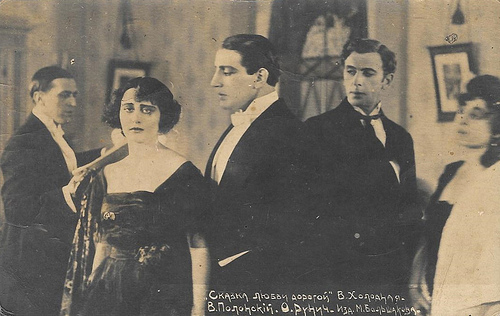
Russian postcard. Collection: Didier Hanson. Vera Kholodnaya , Vitold Polonsky and Ossip Runitsch .
Vitold Polonsky (1879-1919) was one of the most popular actors in pre-Revolutionary Russian cinema.
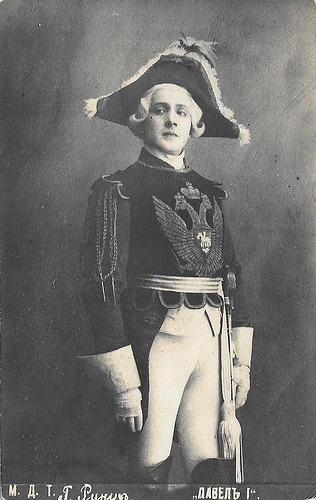
Russian postcard. Collection: Didier Hanson.
Russian actor, producer and stage director Ossip Runitsch (1889-1947) was one of the first idols of the Russian silent cinema.
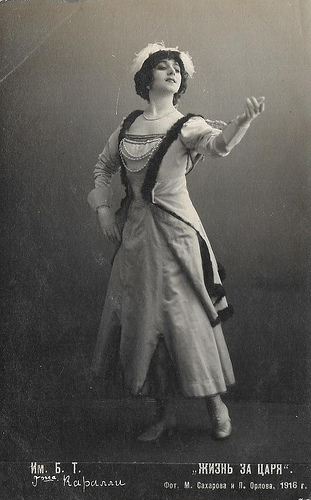
Russian postcard, 1916. Collection: Didier Hanson.
Vera Karalli (1889-1972) was a Russian ballet dancer, choreographer and actress in the early 20th century.
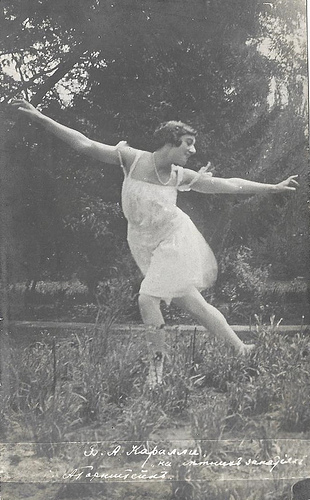
Russian postcard. Collection: Didier Hanson. Vera Karalli .
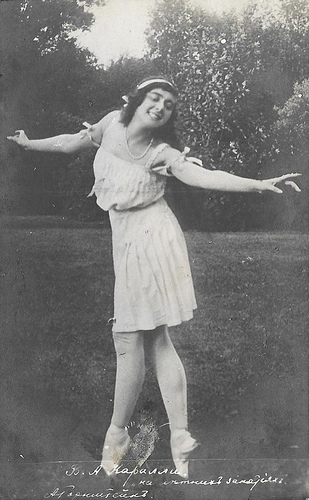
Russian postcard. Collection: Didier Hanson. Vera Karalli .
Thanks again, Didier!
This is a post for Postcard Friendship Friday, hosted by Beth at the The Best Hearts are Crunchy. You can visit her by clicking on the button below.


German postcard. Collection: Didier Hanson.
Anna Pavlova (Russian: Анна Павлова; 1881–1931) was a Russian prima ballerina of the late 19th and the early 20th centuries. She was a principal artist of the Imperial Russian Ballet and the Ballets Russes of Sergei Diaghilev. Pavlova is most recognized for the creation of the role The Dying Swan and, with her own company, became the first ballerina to tour ballet around the world.

German postcard by Verlag Hermann Leiser, Berlin, no. 8615. Photo: Hofphot. E. Bieber, Hamburg. Collection: Didier Hanson.
German actor-director Max Reinhardt (1873-1943) was one of the great innovators of the theatre. He also directed several films, including Sumurûn (1910) and Das Mirakel (1912). In 1934, he went into exile and made in Hollywood A Midsummer Night's Dream (1935).

French postcard, no. R 9. S. Photo: A. Gubtschewsky. C.S. Stanislavsky as Verchinine in the stage production of Les trois soeurs/Three Sisters (Anton Chekhov) by Théâtre Artistique de Moscou (Moscow Art Theatre). Collection: Didier Hanson.
Constantin Sergeievich Stanislavsky (Константи́н Серге́евич Станисла́вский) (1863–1938) was a Russian actor and theatre director. The eponymous Stanislavsky method, or simply 'method acting', has had a pervasive influence on the American theatre and cinema, especially in the period after World War II.

German postcard by Verleih Hermann Leiser, Berlin-Wilmersdorf, no. 7758. Publicity still for Das Mirakel/The Miracle (Michel Carré, 1912). Collection: Didier Hanson.
With her aristocratic air, her severe looks but also her sweet undertones, Italian silent film star and stage actress Maria Carmi (1880-1957) was the cinematic translation of the 19th century Primadonna. Later she became Princess Norina Matchabelli and was co-founder of the perfume company Prince Matchabelli.

German postcard by Verleih Hermann Leiser, Berlin-Wilmersdorf, no. 8634. Photo: Hänse Hermann. Publicity still for Das Mirakel/The Miracle (Michel Carré, 1912). Collection: Didier Hanson. Mary Dietrich as the nun.

German postcard by Verleih Hermann Leiser, Berlin-Wilmersdorf, no. 8500. Photo: Hänse Hermann. Publicity still for Das Mirakel/The Miracle (Michel Carré, 1912). Collection: Didier Hanson. Mary Dietrich as the nun.

Russian postcard. Collection: Didier Hanson.
Vera Kholodnaya (1893-1919) was the first star of the Russian silent cinema. Only 26, the ‘Queen of Screen’ died of the Spanish flu during the pandemic of 1919. Although she worked only three years for the cinema, she must have made between fifty and hundred short films. The Soviet authorities ordered to destroy many of the Kholodnaya features in 1924, and only five of her films still exist.

Russian postcard. Collection: Didier Hanson. Vera Kholodnaya , Vitold Polonsky and Ossip Runitsch .
Vitold Polonsky (1879-1919) was one of the most popular actors in pre-Revolutionary Russian cinema.

Russian postcard. Collection: Didier Hanson.
Russian actor, producer and stage director Ossip Runitsch (1889-1947) was one of the first idols of the Russian silent cinema.

Russian postcard, 1916. Collection: Didier Hanson.
Vera Karalli (1889-1972) was a Russian ballet dancer, choreographer and actress in the early 20th century.

Russian postcard. Collection: Didier Hanson. Vera Karalli .

Russian postcard. Collection: Didier Hanson. Vera Karalli .
Thanks again, Didier!
This is a post for Postcard Friendship Friday, hosted by Beth at the The Best Hearts are Crunchy. You can visit her by clicking on the button below.

Published on November 12, 2015 22:00
November 11, 2015
Jean-Claude Brialy
Jean-Claude Brialy (1933-2007) was a dashing and strikingly versatile French actor. He became a star in the late 1950s when he was one of the best known faces of the Nouvelle Vague. Brialy worked with such New Wave filmmakers as Claude Chabrol, Jean-Luc Godard, Louis Malle, and François Truffaut, and he also directed a number of films himself. It made him an embodiment of the French cinema for a global audience.
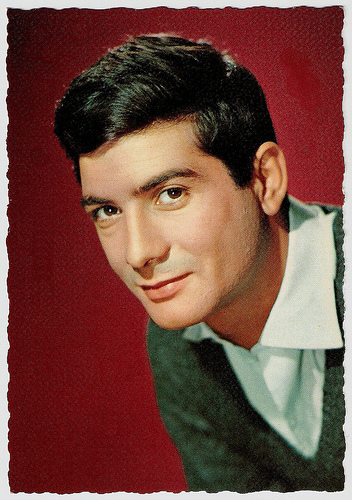
French postcard by E.D.U.G., no. 67. Photo: Sam Lévin.
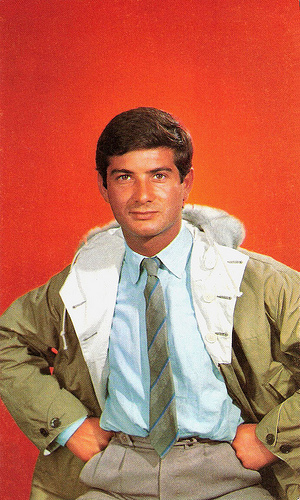
French postcard by E.D.U.G., no. 273, offered by Corvisart, Epinal. Photo: Sam Lévin.
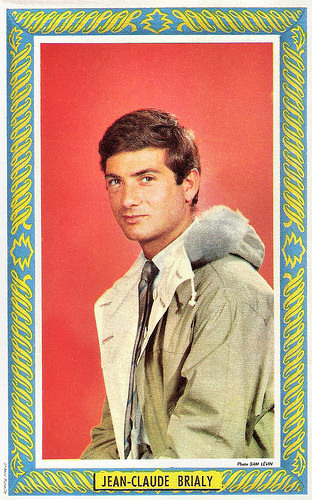
French postcard by St. Anne, Marseille. Photo: Sam Lévin.
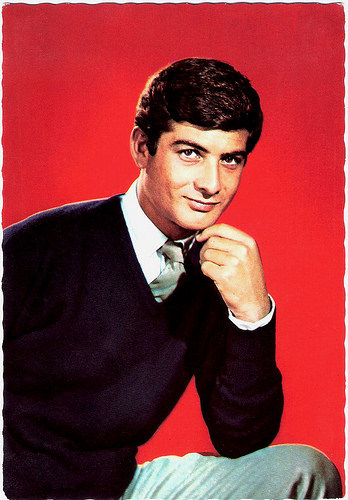
French postcard by E.D.U.G. (Editions du Globe), no. 165. Photo: Sam Lévin.
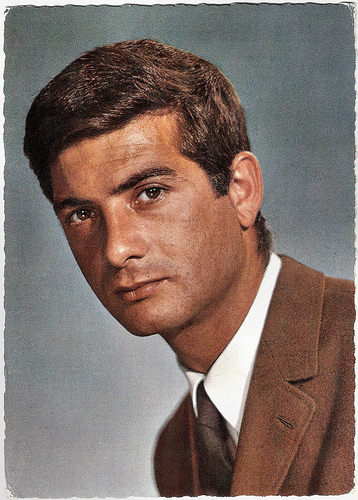
French postcard by E.D.U.G. (Editions du Globe), no. 327. Photo: Sam Lévin.
Acting as an early form of rebellion
Jean-Claude Brialy was born in Aumale, French Algeria (now Sour El-Ghozlane, Algeria), in 1933. He was the son of Roger Brialy, a colonel stationed in colonial Algeria with the French Army, and Suzanne Abraham. At the age of nine, he went with his family to various cities in France, settling after the war in Strasbourg, where he took his ´baccalaureate´.
Brialy showed great promise in drama and won first prize at the Conservatoire de Strasbourg. He detested his strict upbringing, and acting became an early form of rebellion. He had violent arguments with his father, who once locked the 15-year-old boy in to prevent his attending rehearsals of a school play. Jean-Claude responded by smashing up the furniture. No doubt there was further trouble when Jean-Claude revealed that he was homosexual.
Against the wishes of his parents, he enrolled at the Centre Dramatique de l’Est (Eastern Centre of Dramatic Art in Strasbourg), to train to be an actor. Military service then intervened and Brialy found himself attached to an army film unit in the German town of Baden-Baden. There he made his first film, a short entitled Chiffonard et Bon Aloi/Chiffonard and Good Taste (Phierre Lhomme, 1954). His job also enabled him to go to shows, and to meet actors, including Jean Marais .
Demobilized, he moved to Paris in 1954. There he scratched a living by small roles on stage and entertaining the queues outside the first-run cinemas on the Champs Elysees. He became friendly with a group of young critics and aspiring filmmakers who were taking over the influential journal Cahiers du Cinéma. At 21, he joined a Cahiers outing to Arles to see Jean Renoir's stage production of William Shakespeare's Julius Caesar.
He made his film debut in a short directed by one of the Cahiers critics, Le Coup du berger/Fool's Mate (Jacques Rivette, 1956). Cahiers editor Eric Rohmer cast him as the lover in his 10-minute short La sonate à Kreutzer/The Kreutzer Sonata (1956), an adaptation of the short story by Leo Tolstoy. Brialy appeared uncredited in two features by Louis Malle: Les Amants/The Lovers (Louis Malle, 1958) and Ascenseur pour l’échafaud/Elevator to the Gallows (Louis Malle, 1958), two instant classics starring Jeanne Moreau .
His first lead was in Le beau Serge/Handsome Serge (Claude Chabrol, 1958) as an idealistic Parisian student who returns after a ten-year absence to his provincial village and becomes obsessed with saving an old school friend who has become a hopeless alcoholic (played by the brooding Gérard Blain , often called the James Dean of France). The film, which won an award in Locarno, and the Jean-Vigo Prize, immediately attracted attention, and the performers (Brialy, Blain, and Bernadette Lafont ) were widely acclaimed. Le beau Serge was followed by another film by Claude Chabrol, Les Cousins/The Cousins (1959), in which Brialy played the sardonic town cousin to Blain's simple country cousin.
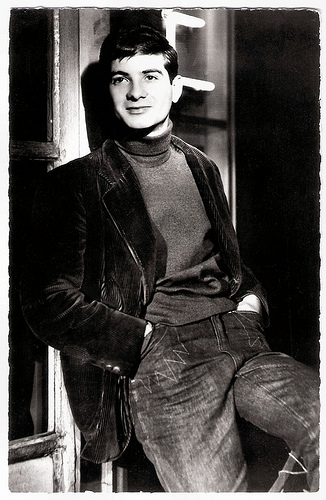
French postcard by Editions du Globe, Paris, no. 775. Photo: Studio Vauclair.
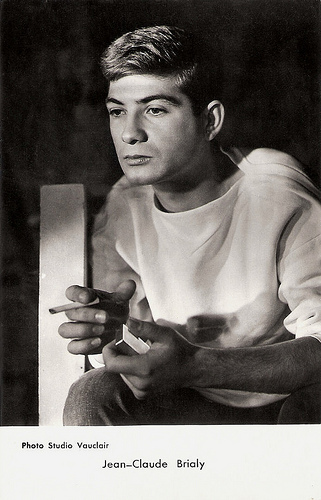
French postcard by Editions P.I., presented by Les Carbones Korès 'Carboplane', no. 1104A. Photo: Studio Vauclair.
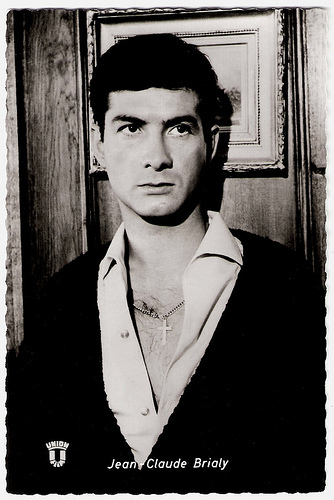
German postcard by Kolibri-Verlag G.m.b.H., Minden/Westf., no. 1383. Photo: Union-Film. Publicity still for Le gigolo/The Gigolo (Jacques Deray, 1960).
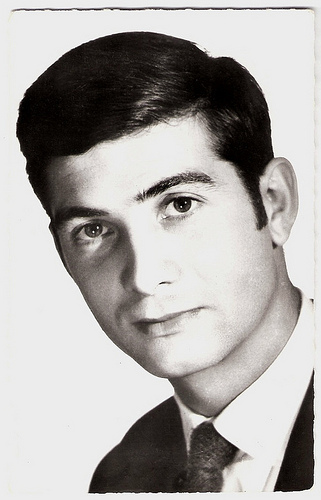
French postcard by Editions du Globe (E.D.U.G.), no. 832. Photo: Sam Lévin.
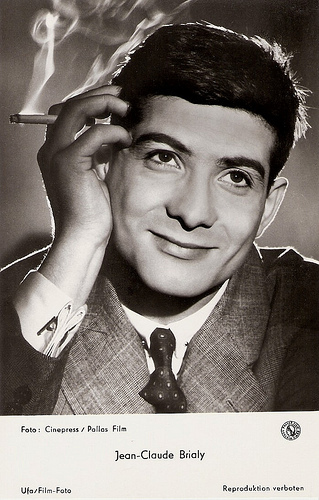
German postcard for Ufa (Universum-Film Aktiengesellschaft), Berlin-Tempelhof, no. FK 4505. Retail price: 25 Pfg. Photo: Cinepress / Pallas Film.
A Period of Frantic Renaissance
The young Turks of the Cahiers du Cinema formed the core of the Nouvelle Vague (New Wave). This film movement was a rebellion against the conventions of the French cinema. As James Travers comments at Films de France : ”Out went polished scripts, well-rehearsed performances and meticulously staged productions. In came spontaneity, improvisation, subversive politics, real human emotion, and fun.”
The Cahiers critics were starting to have an impact far greater than they could have anticipated and the French cinema seemed to be going through a period of frantic renaissance. The director became the intellectual author of the film; the stars were made more human, the stories more enigmatic. Jean-Claude Brialy made several films with Nouvelle Vague filmmakers including Jean-Luc Godard, François Truffaut, Agnès Varda, Pierre Kast, and Jacques Rozier.
Ronald Bergan stated in The Guardian : “Where (Jean-Paul) Belmondo represented anarchy, (Jean-Pierre) Léaud youthful innocence and Blain sensitivity, Brialy brought cynicism, charm and sophistication to the films of the period.”
Brialy was the leading man in Godard’s ‘neo-realist musical’ Une Femme est une femme/Woman Is a Woman (Jean-Luc Godard, 1961), in which Anna Karina plays a stripper who wants to have his baby and turns to his best friend Jean-Paul Belmondo when he refuses. In the film Brialy directly addresses the audience with a line that became an epigram for the Nouvelle Vague: “It’s hard to tell if this is a comedy or a tragedy, but either way it’s a masterpiece.”
For Truffaut he appeared opposite Jeanne Moreau in La Mariée était en noir/The Bride Wore Black (François Truffaut, 1968), and for Rohmer he starred in Le Genou de Claire/Claire’s Knee (Éric Rohmer, 1970), in which he played a bearded cultural attache who is taking his last summer holiday as a bachelor at Annecy and becomes filled with desire for a young woman’s knee.
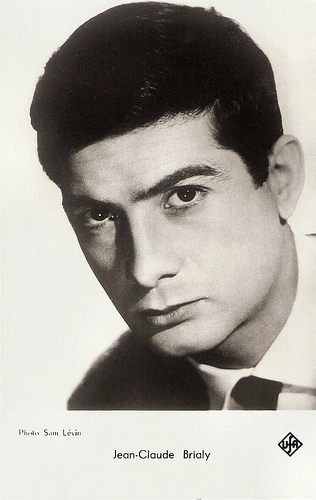
French postcard by Editions P.I., offered by Delespaul, Lille, no. FK 85. Photo: Sam Lévin / Ufa. (Editions P.I. was the licence holder for the Ufa postcards in France.)
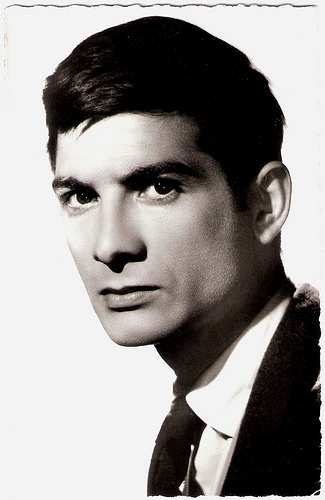
French postcard by Editions du Globe, no. 864. Photo: Sam Lévin.
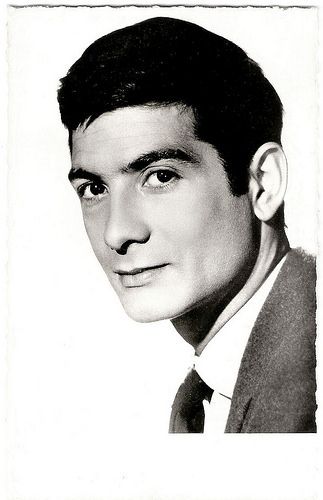
French postcard by Editions P.I., Paris, offered by Les Carbones Korès 'Carboplane', no. 1023. Photo: Sam Lévin.
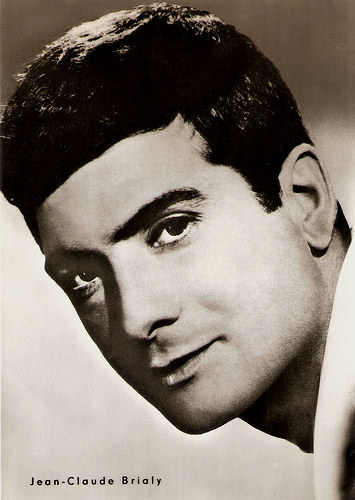
East-German postcard by VEB Progress Film-Vertrieb, Berlin, no. 19/71. Photo: Steffen.
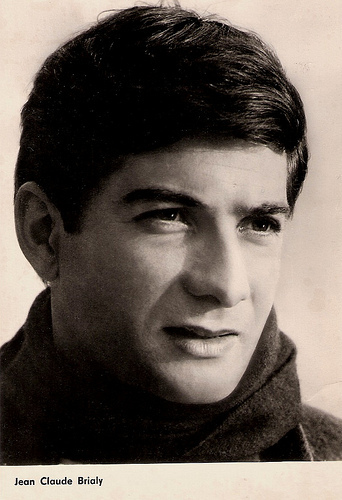
East-German card by VEB Progress Film-Vertrieb, Berlin, no. 1/972.
Gay Uncle
Besides his work for the Nouvelle Vague, Jean-Claude Brialy also worked with many other well known filmmakers. He made his feature film debut in Jean Renoir’s Elena et les hommes/Elena and her Men (1956) and played his first substantial role, in L’Ami de la famille/A Friend of the Family (Jacques Pinoteau, 1957). Then came a supporting role in Christine (Pierre Gaspard-Huit, 1958), starring Romy Schneider , who would become a close personal friend.
Brialy appeared with Alida Valli in Le Gigolo/The Gigolo (Jacques Deray, 1960), with Anthony Perkins in Le Glaive et la Balance/The Sword and the Balance (André Cayatte, 1963) and with Jane Fonda in La ronde/Circle of Love (1964), Roger Vadim's adaptation of the classic Arthur Schnitzler play about various people having affairs. He was an asylum inmate in Le Roi de Coeur/King of Hearts (Philippe de Broca, 1966), which became a US hit.
In the following decades he worked with major film directors like Luis Buñuel (Le Fantôme de la liberté/The Phantom of Liberty, 1974), Bertrand Tavernier (Le Juge et l’assassin/The Judge and the Assassin, 1976) and Ettore Scola (La Nuit de Varennes/That Night in Varennes, 1982). He was equally attracted to popular comedies, such as Le Maître-nageur/The Swimming Instructor (Jean-Louis Trintignant, 1978) and Pinot simple flic/Pinot, Simple Cop (Gérard Jugnot, 1984).
He reunited with Claude Chabrol and Bernadette Lafont for Inspecteur Lavardin/Inspector Lavardin (Claude Chabrol, 1986) in which he played a gay uncle. Other notable appearances include Les uns et les autres/Bolero (Claude Lelouch, 1981), Mortelle Randonnée/Deadly Circuit (Claude Miller, 1982), and La Reine Margot/Queen Margot (Patrice Chéreau, 1994) starring Isabelle Adjani .
Brialy also directed a dozen (TV) films himself, including Églantine (1971), an enchanting story set in the 19th century of a boy's visit to his grandmother, and Un Amour De Pluie/Loving in the Rain (1974) starring Romy Schneider as a woman who takes her daughter to a summer resort in search of a love affair. He often appeared in supporting roles, and was nominated for a César for the best supporting actor for his role in Le Juge et l’Assassin/The Judge and the Assassin (Bertrand Tavernier, 1976), but he won the César for Les Innocents/The Innocents (André Téchiné, 1988).
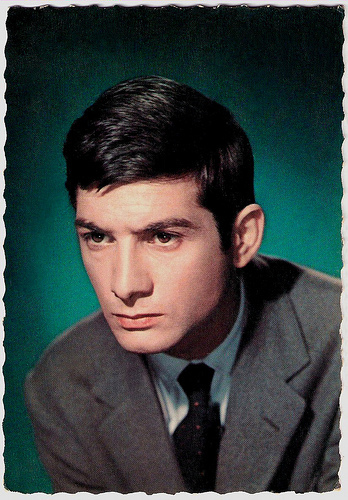
French postcard by E.D.U.G., no. 43. Photo: Sam Lévin.
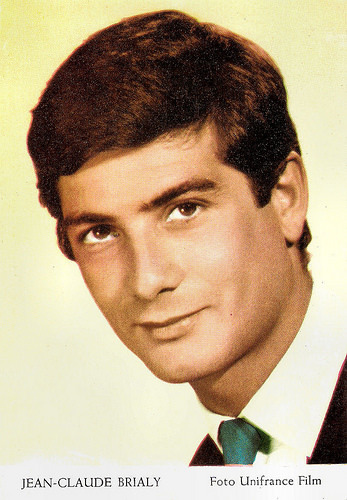
Vintage card. Photo: Unifrance Film.
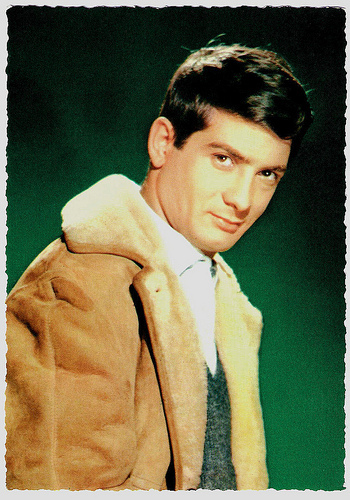
French postcard by C.B.
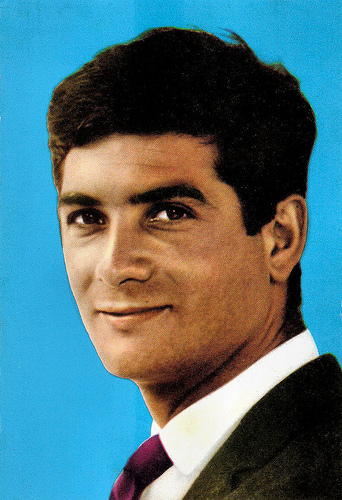
Spanish postcard by Postalco, Barcelona, no. 20/7. Photo: Unifrance Film.
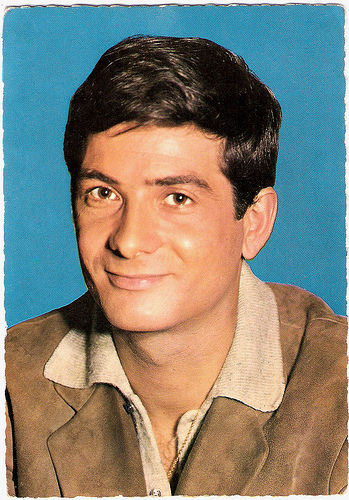
French postcard by E.D.U.G., no. 220. Photo: Studio Petri.
Bon Vivant
Jean-Claude Brialy came to personify all that is best in French culture. A bon vivant, he started his own restaurant in 1966: the popular L'Orangerie, on the Île Saint-Louis in Paris, which he owned for two decades. He was a natural conteur, and he revelled in his numerous television and radio appearances.
As a lover of literature, he read extensively and wrote several best-selling books, including the memoirs, Le Ruisseau des singes (River of Monkeys) (2000) and J'ai oublié de vous dire... (I Forgot to Tell You ...) (2004). And he was also a man of the stage. His theatrical successes include Georges Feydeau’s La Puce à l’oreille (A Flea in Her Ear, 1968) and Hotel Paradiso (1974), and Sacha Guitry ’s Desiré (1984).
When he wasn’t treading the boards, he was helping to direct theatres and film festivals. As James Travers writes at Films de France : “It’s no wonder that he became one of the best loved and most highly respected figures in France.” For his exceptional contribution to French culture, he was awarded the Légion d’honneur (the Legion of Honour).
In his last film, made for television, Brialy gave his best performance in years, as the gay Jewish poet Max Jacob in Monsieur Max (Gabriel Aghion, 2007), who converted to Catholicism and died in a Gestapo internment camp.
Following a long illness, Jean-Claude Brialy died of cancer in 2007, in his house in Monthyon, France. He was 74. In over more than a half-century, Brialy appeared in 185 films and television shows. He is cited in The Guardian saying: "Out of the 185 films, I must admit that I've enjoyed myself 185 times".
Trailer Le beau Serge/Handsome Serge (1958). Source: Gaumont (YouTube).
Trailer Les Cousins (1959). Source: Malenpis (YouTube).
Trailer for Une Femme est une femme/Woman Is a Woman (1961). Source: Kanál uživatele precija (YouTube).
Trailer of Le genou de Claire/Claire’s Knee (1970). Source: Video Detective (YouTube).
French trailer of Inspecteur Lavardin (1986) . Source: Cohen Film Collection (YouTube).
Sources: James Travers (Films de France), Ronald Bergan (The Guardian), Tim Weiner (The New York Times), Jean Roy (L’Humanité), Adam Bernstein (Washington Post), Hal Erickson (AllMovie), The Independent, Film Reference, Wikipedia and .

French postcard by E.D.U.G., no. 67. Photo: Sam Lévin.

French postcard by E.D.U.G., no. 273, offered by Corvisart, Epinal. Photo: Sam Lévin.

French postcard by St. Anne, Marseille. Photo: Sam Lévin.

French postcard by E.D.U.G. (Editions du Globe), no. 165. Photo: Sam Lévin.

French postcard by E.D.U.G. (Editions du Globe), no. 327. Photo: Sam Lévin.
Acting as an early form of rebellion
Jean-Claude Brialy was born in Aumale, French Algeria (now Sour El-Ghozlane, Algeria), in 1933. He was the son of Roger Brialy, a colonel stationed in colonial Algeria with the French Army, and Suzanne Abraham. At the age of nine, he went with his family to various cities in France, settling after the war in Strasbourg, where he took his ´baccalaureate´.
Brialy showed great promise in drama and won first prize at the Conservatoire de Strasbourg. He detested his strict upbringing, and acting became an early form of rebellion. He had violent arguments with his father, who once locked the 15-year-old boy in to prevent his attending rehearsals of a school play. Jean-Claude responded by smashing up the furniture. No doubt there was further trouble when Jean-Claude revealed that he was homosexual.
Against the wishes of his parents, he enrolled at the Centre Dramatique de l’Est (Eastern Centre of Dramatic Art in Strasbourg), to train to be an actor. Military service then intervened and Brialy found himself attached to an army film unit in the German town of Baden-Baden. There he made his first film, a short entitled Chiffonard et Bon Aloi/Chiffonard and Good Taste (Phierre Lhomme, 1954). His job also enabled him to go to shows, and to meet actors, including Jean Marais .
Demobilized, he moved to Paris in 1954. There he scratched a living by small roles on stage and entertaining the queues outside the first-run cinemas on the Champs Elysees. He became friendly with a group of young critics and aspiring filmmakers who were taking over the influential journal Cahiers du Cinéma. At 21, he joined a Cahiers outing to Arles to see Jean Renoir's stage production of William Shakespeare's Julius Caesar.
He made his film debut in a short directed by one of the Cahiers critics, Le Coup du berger/Fool's Mate (Jacques Rivette, 1956). Cahiers editor Eric Rohmer cast him as the lover in his 10-minute short La sonate à Kreutzer/The Kreutzer Sonata (1956), an adaptation of the short story by Leo Tolstoy. Brialy appeared uncredited in two features by Louis Malle: Les Amants/The Lovers (Louis Malle, 1958) and Ascenseur pour l’échafaud/Elevator to the Gallows (Louis Malle, 1958), two instant classics starring Jeanne Moreau .
His first lead was in Le beau Serge/Handsome Serge (Claude Chabrol, 1958) as an idealistic Parisian student who returns after a ten-year absence to his provincial village and becomes obsessed with saving an old school friend who has become a hopeless alcoholic (played by the brooding Gérard Blain , often called the James Dean of France). The film, which won an award in Locarno, and the Jean-Vigo Prize, immediately attracted attention, and the performers (Brialy, Blain, and Bernadette Lafont ) were widely acclaimed. Le beau Serge was followed by another film by Claude Chabrol, Les Cousins/The Cousins (1959), in which Brialy played the sardonic town cousin to Blain's simple country cousin.

French postcard by Editions du Globe, Paris, no. 775. Photo: Studio Vauclair.

French postcard by Editions P.I., presented by Les Carbones Korès 'Carboplane', no. 1104A. Photo: Studio Vauclair.

German postcard by Kolibri-Verlag G.m.b.H., Minden/Westf., no. 1383. Photo: Union-Film. Publicity still for Le gigolo/The Gigolo (Jacques Deray, 1960).

French postcard by Editions du Globe (E.D.U.G.), no. 832. Photo: Sam Lévin.

German postcard for Ufa (Universum-Film Aktiengesellschaft), Berlin-Tempelhof, no. FK 4505. Retail price: 25 Pfg. Photo: Cinepress / Pallas Film.
A Period of Frantic Renaissance
The young Turks of the Cahiers du Cinema formed the core of the Nouvelle Vague (New Wave). This film movement was a rebellion against the conventions of the French cinema. As James Travers comments at Films de France : ”Out went polished scripts, well-rehearsed performances and meticulously staged productions. In came spontaneity, improvisation, subversive politics, real human emotion, and fun.”
The Cahiers critics were starting to have an impact far greater than they could have anticipated and the French cinema seemed to be going through a period of frantic renaissance. The director became the intellectual author of the film; the stars were made more human, the stories more enigmatic. Jean-Claude Brialy made several films with Nouvelle Vague filmmakers including Jean-Luc Godard, François Truffaut, Agnès Varda, Pierre Kast, and Jacques Rozier.
Ronald Bergan stated in The Guardian : “Where (Jean-Paul) Belmondo represented anarchy, (Jean-Pierre) Léaud youthful innocence and Blain sensitivity, Brialy brought cynicism, charm and sophistication to the films of the period.”
Brialy was the leading man in Godard’s ‘neo-realist musical’ Une Femme est une femme/Woman Is a Woman (Jean-Luc Godard, 1961), in which Anna Karina plays a stripper who wants to have his baby and turns to his best friend Jean-Paul Belmondo when he refuses. In the film Brialy directly addresses the audience with a line that became an epigram for the Nouvelle Vague: “It’s hard to tell if this is a comedy or a tragedy, but either way it’s a masterpiece.”
For Truffaut he appeared opposite Jeanne Moreau in La Mariée était en noir/The Bride Wore Black (François Truffaut, 1968), and for Rohmer he starred in Le Genou de Claire/Claire’s Knee (Éric Rohmer, 1970), in which he played a bearded cultural attache who is taking his last summer holiday as a bachelor at Annecy and becomes filled with desire for a young woman’s knee.

French postcard by Editions P.I., offered by Delespaul, Lille, no. FK 85. Photo: Sam Lévin / Ufa. (Editions P.I. was the licence holder for the Ufa postcards in France.)

French postcard by Editions du Globe, no. 864. Photo: Sam Lévin.

French postcard by Editions P.I., Paris, offered by Les Carbones Korès 'Carboplane', no. 1023. Photo: Sam Lévin.

East-German postcard by VEB Progress Film-Vertrieb, Berlin, no. 19/71. Photo: Steffen.

East-German card by VEB Progress Film-Vertrieb, Berlin, no. 1/972.
Gay Uncle
Besides his work for the Nouvelle Vague, Jean-Claude Brialy also worked with many other well known filmmakers. He made his feature film debut in Jean Renoir’s Elena et les hommes/Elena and her Men (1956) and played his first substantial role, in L’Ami de la famille/A Friend of the Family (Jacques Pinoteau, 1957). Then came a supporting role in Christine (Pierre Gaspard-Huit, 1958), starring Romy Schneider , who would become a close personal friend.
Brialy appeared with Alida Valli in Le Gigolo/The Gigolo (Jacques Deray, 1960), with Anthony Perkins in Le Glaive et la Balance/The Sword and the Balance (André Cayatte, 1963) and with Jane Fonda in La ronde/Circle of Love (1964), Roger Vadim's adaptation of the classic Arthur Schnitzler play about various people having affairs. He was an asylum inmate in Le Roi de Coeur/King of Hearts (Philippe de Broca, 1966), which became a US hit.
In the following decades he worked with major film directors like Luis Buñuel (Le Fantôme de la liberté/The Phantom of Liberty, 1974), Bertrand Tavernier (Le Juge et l’assassin/The Judge and the Assassin, 1976) and Ettore Scola (La Nuit de Varennes/That Night in Varennes, 1982). He was equally attracted to popular comedies, such as Le Maître-nageur/The Swimming Instructor (Jean-Louis Trintignant, 1978) and Pinot simple flic/Pinot, Simple Cop (Gérard Jugnot, 1984).
He reunited with Claude Chabrol and Bernadette Lafont for Inspecteur Lavardin/Inspector Lavardin (Claude Chabrol, 1986) in which he played a gay uncle. Other notable appearances include Les uns et les autres/Bolero (Claude Lelouch, 1981), Mortelle Randonnée/Deadly Circuit (Claude Miller, 1982), and La Reine Margot/Queen Margot (Patrice Chéreau, 1994) starring Isabelle Adjani .
Brialy also directed a dozen (TV) films himself, including Églantine (1971), an enchanting story set in the 19th century of a boy's visit to his grandmother, and Un Amour De Pluie/Loving in the Rain (1974) starring Romy Schneider as a woman who takes her daughter to a summer resort in search of a love affair. He often appeared in supporting roles, and was nominated for a César for the best supporting actor for his role in Le Juge et l’Assassin/The Judge and the Assassin (Bertrand Tavernier, 1976), but he won the César for Les Innocents/The Innocents (André Téchiné, 1988).

French postcard by E.D.U.G., no. 43. Photo: Sam Lévin.

Vintage card. Photo: Unifrance Film.

French postcard by C.B.

Spanish postcard by Postalco, Barcelona, no. 20/7. Photo: Unifrance Film.

French postcard by E.D.U.G., no. 220. Photo: Studio Petri.
Bon Vivant
Jean-Claude Brialy came to personify all that is best in French culture. A bon vivant, he started his own restaurant in 1966: the popular L'Orangerie, on the Île Saint-Louis in Paris, which he owned for two decades. He was a natural conteur, and he revelled in his numerous television and radio appearances.
As a lover of literature, he read extensively and wrote several best-selling books, including the memoirs, Le Ruisseau des singes (River of Monkeys) (2000) and J'ai oublié de vous dire... (I Forgot to Tell You ...) (2004). And he was also a man of the stage. His theatrical successes include Georges Feydeau’s La Puce à l’oreille (A Flea in Her Ear, 1968) and Hotel Paradiso (1974), and Sacha Guitry ’s Desiré (1984).
When he wasn’t treading the boards, he was helping to direct theatres and film festivals. As James Travers writes at Films de France : “It’s no wonder that he became one of the best loved and most highly respected figures in France.” For his exceptional contribution to French culture, he was awarded the Légion d’honneur (the Legion of Honour).
In his last film, made for television, Brialy gave his best performance in years, as the gay Jewish poet Max Jacob in Monsieur Max (Gabriel Aghion, 2007), who converted to Catholicism and died in a Gestapo internment camp.
Following a long illness, Jean-Claude Brialy died of cancer in 2007, in his house in Monthyon, France. He was 74. In over more than a half-century, Brialy appeared in 185 films and television shows. He is cited in The Guardian saying: "Out of the 185 films, I must admit that I've enjoyed myself 185 times".
Trailer Le beau Serge/Handsome Serge (1958). Source: Gaumont (YouTube).
Trailer Les Cousins (1959). Source: Malenpis (YouTube).
Trailer for Une Femme est une femme/Woman Is a Woman (1961). Source: Kanál uživatele precija (YouTube).
Trailer of Le genou de Claire/Claire’s Knee (1970). Source: Video Detective (YouTube).
French trailer of Inspecteur Lavardin (1986) . Source: Cohen Film Collection (YouTube).
Sources: James Travers (Films de France), Ronald Bergan (The Guardian), Tim Weiner (The New York Times), Jean Roy (L’Humanité), Adam Bernstein (Washington Post), Hal Erickson (AllMovie), The Independent, Film Reference, Wikipedia and .
Published on November 11, 2015 22:00
November 10, 2015
All'ombra di un trono (1921)
Polish diva Soava Gallone (1880-1957) starred in the Italian silent melodrama All'ombra di un trono/In the Shadow of a Throne (1921) directed by her husband Carmine Gallone for their own production company Films Gallone. Other actors were Umberto Casilini, Piero Schiavazzi and the child actor Marcella Sabbatini.
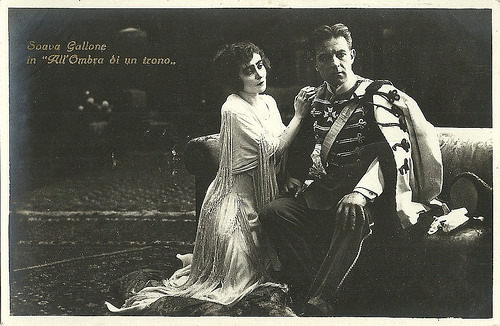
Italian postcard by G. B. Falci, Milano. Photo: publicity still for All'ombra di un trono/In the Shadow of a Throne (Carmine Gallone, 1921).
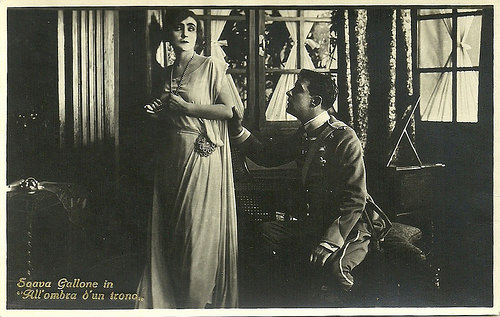
Italian postcard by G. B. Falci, Milano, no. 94. Photo: publicity still for All'ombra di un trono/In the Shadow of a Throne (Carmine Gallone, 1921).

Italian postcard by G. B. Falci, Milano, no. 224. Photo: publicity still for All'ombra di un trono/In the Shadow of a Throne (Carmine Gallone, 1921).
Ruritania-like story
All'ombra di un trono/In the Shadow of a Throne aka L'Ombra di un trono (Carmine Gallone, 1921) was based on Fleur d'ombre, a French novel by Charles Folly.
When the legitimate heir to a throne has mysteriously killed himself, his brother (Piero Schiavazzi) becomes king. The iron law obliges the young and inexpert prince to abandon his affair with a bourgeois girl ( Soava Gallone ), with whom he is in love.
The renouncement of (but then revocation) of real love, the court intrigues, and a final duel are the ingredients of this Ruritania-like story.
All'ombra di un trono/In the Shadow of a Throne was released in Italy only in 1923. While press though it was outdated, audiences flocked to see it.
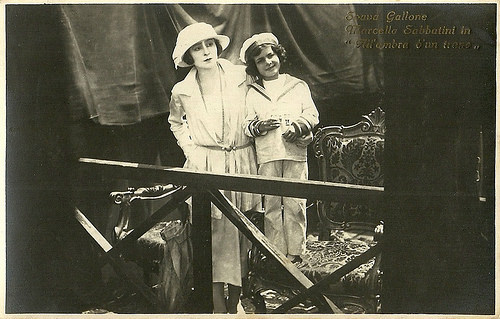
Italian postcard by G. B. Falci, Milano, no. 115. Photo: publicity still for All'ombra di un trono/In the Shadow of a Throne (Carmine Gallone, 1921).
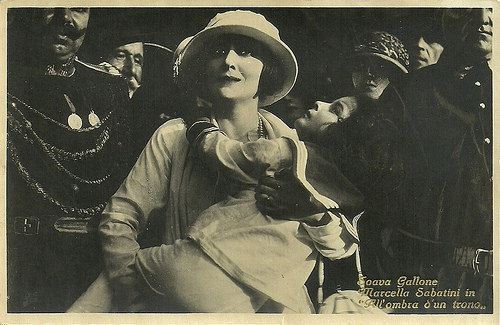
Italian postcard by G. B. Falci, Milano, no. 117. Photo: publicity still for All'ombra di un trono/In the Shadow of a Throne (Carmine Gallone, 1921).
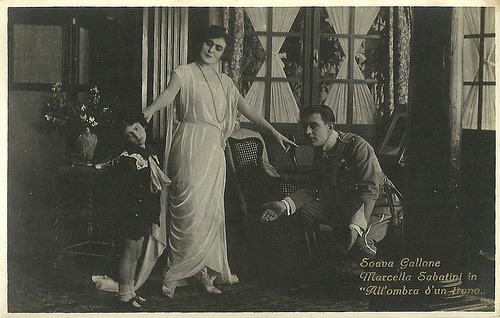
Italian postcard by G. B. Falci, Milano, no. 172. Photo: publicity still for All'ombra di un trono/In the Shadow of a Throne (Carmine Gallone, 1921).
Sources: Vittorio Martinelli (Il cinema muto italiano 1921-1922 - Italian) and IMDb.

Italian postcard by G. B. Falci, Milano. Photo: publicity still for All'ombra di un trono/In the Shadow of a Throne (Carmine Gallone, 1921).

Italian postcard by G. B. Falci, Milano, no. 94. Photo: publicity still for All'ombra di un trono/In the Shadow of a Throne (Carmine Gallone, 1921).

Italian postcard by G. B. Falci, Milano, no. 224. Photo: publicity still for All'ombra di un trono/In the Shadow of a Throne (Carmine Gallone, 1921).
Ruritania-like story
All'ombra di un trono/In the Shadow of a Throne aka L'Ombra di un trono (Carmine Gallone, 1921) was based on Fleur d'ombre, a French novel by Charles Folly.
When the legitimate heir to a throne has mysteriously killed himself, his brother (Piero Schiavazzi) becomes king. The iron law obliges the young and inexpert prince to abandon his affair with a bourgeois girl ( Soava Gallone ), with whom he is in love.
The renouncement of (but then revocation) of real love, the court intrigues, and a final duel are the ingredients of this Ruritania-like story.
All'ombra di un trono/In the Shadow of a Throne was released in Italy only in 1923. While press though it was outdated, audiences flocked to see it.

Italian postcard by G. B. Falci, Milano, no. 115. Photo: publicity still for All'ombra di un trono/In the Shadow of a Throne (Carmine Gallone, 1921).

Italian postcard by G. B. Falci, Milano, no. 117. Photo: publicity still for All'ombra di un trono/In the Shadow of a Throne (Carmine Gallone, 1921).

Italian postcard by G. B. Falci, Milano, no. 172. Photo: publicity still for All'ombra di un trono/In the Shadow of a Throne (Carmine Gallone, 1921).
Sources: Vittorio Martinelli (Il cinema muto italiano 1921-1922 - Italian) and IMDb.
Published on November 10, 2015 22:00
November 9, 2015
Dora van der Groen (1927-2015)
On 8 November, Belgian actress and theatre director Dora van der Groen (1927-2015) passed away. She starred with Julien Schoenaerts in the 'first Belgian film' Meeuwen sterven in de haven/Seagulls Die in the Harbour (1955) and with Kees Brusse in the Dutch classic Dokter Pulder zaait papavers/Doctor Pulder Sows Poppies (1975). She appeared in more than 120 films and television shows between 1945 and 2003.
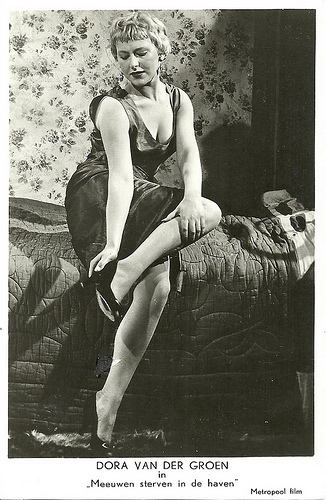
Belgian postcard by Ed. Privot, Antwerp. Photo: Metropool Film. Publicity still for Meeuwen sterven in de haven/Seagulls Die in the Harbour (Rik Kuypers, Ivo Michiels and Roland Verhavert, 1955) with Dora van der Groen as the Prostitute.
The first Belgian film
Dora van der Groen was born on March 10, 1927 in Antwerp, Belgium.
She began her acting career at the Koninlijke Nederlandse Schouwburg (Royal Dutch Theatre) in Antwerp. Later, she played at the Koninklijke Vlaamse Schouwburg (Royal Flemish Theatre) in Brussels. For many years, she was also artistic director of the theatre department of the Royal Flemish Conservatory in Antwerp.
She made her film debut in the Belgian comedy Baas Gansendonck/Boss Gansendonck (Gaston Ariën, 1945), based on a novel by Hendrik Conscience.
In 1955, she played the female lead as a prostitute opposite Julien Schoenaerts in the Belgian drama film Meeuwen sterven in de haven/Seagulls Die in the Harbour (Rik Kuypers, Ivo Michiels and Roland Verhavert, 1955), which was entered into the 1956 Cannes Film Festival. The film made a great impression on the press and public. Both the theme and the stylistic program introduced a new, more internationally oriented sensibility in the cinema for Flanders. In many reviews Meeuwen was unreservedly hailed as ‘the first Flemish' or even the ‘first Belgian film'.
Van der Groen became a much sought-after television actor, and played in series such as Wij, Heren van Zichem/We, Gentlemen of Zichem (Maurits Balfoort, 1969), Tussen wal en schip/Between two stools (Eimert Kruidhof, 1977), De Bossen van Vlaanderen/The woods of Flanders Marc Lybaert, 1991), Moeder, waarom leven wij/Mother, why do we live (Guido Henderickx, 1993), and Terug naar Oosterdonk/Back to Oosterdonk (Frank Van Passel, 1997).
Wij, heren van Zichem/We, Gentlemen from Zichem (Maurits Balfoort, 1969) was a very authentic Flemisch TV series. A soap avant-la-lettre about a devout Catholic village, with numerous story-lines on human themes such as affection, jealousy, greed, family - and social life. The series elaborates on the adventures of the blond rascal Lewie, the title character of Ernest Claes' hit-novel De Witte/The White One. Lewie's eternal mischief makes life difficult for his family, friends, people at school and the other inhabitants of the village.
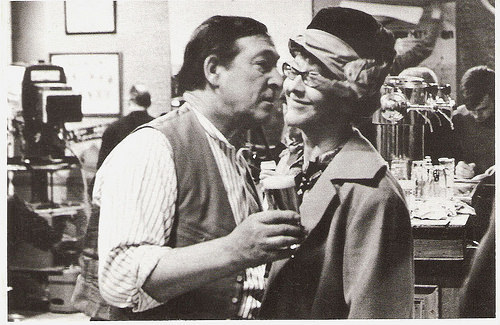
Belgian postcard by Best, Antwerpen, no 30. Photo: Humo. Publicity still for the TV series Wij, heren van Zichem/We, gentlemen from Zichem (Maurits Balfoort, 1969) with Robert Marcel as Jef de Smid and Dora van der Groen as Melanie.
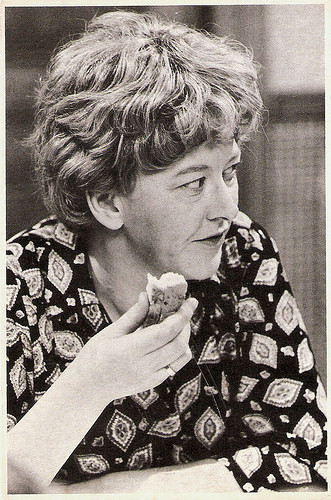
Belgian postcard by Best, Antwerpen, no. 34. Photo: Humo. Publicity still for the TV series Wij, heren van Zichem/We, gentlemen from Zichem (Maurits Balfoort, 1969) with Dora van der Groen as Melanie.
Feminist fairy-tale
Dora van der Groen also appeared in several Belgian and Dutch films. In 1969, she appeared in the Belgian-Dutch drama Monsieur Hawarden (Harry Kümel, 1969) with Ellen Vogel as a woman who disguises herself as a man to avoid prosecution for murdering her lover fifteen years ago. Van der Groen also appeared in Kümel’s fantasy-horror Malpertuis/The Legend of Doom House (Harry Kümel, 1971) with Orson Welles .
She had a small part in the French film La Maison sous les arbres/The Deadly Trap (René Clément, 1971) starring Faye Dunaway . She co-starred with Kees Brusse in the drama-comedy Dokter Pulder zaait papavers/Doctor Pulder Sows Poppies (Bert Haanstra, 1975), which was entered into the 26th Berlin International Film Festival.
Other successful films were Dagboek van een Oude Dwaas/Diary of a Mad Old Man (Lili Rademakers, 1987) based on a book by Jun'ichirō Tanizaki, the Dutch drama Havinck (Frans Weisz, 1987) with Willem Nijholt , and the feminist fairy-tale Antonia/Antonia's Line (Marleen Gorris, 1995) featuring Willeke van Ammelrooy. Antonia won the Academy Award for Best Foreign Language Film at the 68th Academy Awards.
In the film Pauline & Paulette (Lieven Debrauwer, 2001), Van der Groen played the mentally handicapped Pauline opposite Ann Petersen as her sister Paulette. Van der Groen herself stayed for several years in a housing project for people with dementia. Earlier, she had performed a demented woman in the short film Leonie (1996), and in Villa des Roses (Frank Van Passel, 2002).
Dora van der Groen was married to the actor Tone Brulin and later to actor and TV host Wies Andersen. Both marriages ended in a divorce. She had three sons. Her youngest son is director Brick de Bois. Dora van der Groen was 88.
Trailer Meeuwen sterven in de haven/Seagulls Die in the Harbour (1955). Source: Ximon NL (YouTube).
American trailer for Pauline & Paulette (Lieven Debrauwer, 2001). Source: Lieven Debrauwer (YouTube).
Sources: HLN.be (Dutch), Wikipedia (English and Dutch) and .

Belgian postcard by Ed. Privot, Antwerp. Photo: Metropool Film. Publicity still for Meeuwen sterven in de haven/Seagulls Die in the Harbour (Rik Kuypers, Ivo Michiels and Roland Verhavert, 1955) with Dora van der Groen as the Prostitute.
The first Belgian film
Dora van der Groen was born on March 10, 1927 in Antwerp, Belgium.
She began her acting career at the Koninlijke Nederlandse Schouwburg (Royal Dutch Theatre) in Antwerp. Later, she played at the Koninklijke Vlaamse Schouwburg (Royal Flemish Theatre) in Brussels. For many years, she was also artistic director of the theatre department of the Royal Flemish Conservatory in Antwerp.
She made her film debut in the Belgian comedy Baas Gansendonck/Boss Gansendonck (Gaston Ariën, 1945), based on a novel by Hendrik Conscience.
In 1955, she played the female lead as a prostitute opposite Julien Schoenaerts in the Belgian drama film Meeuwen sterven in de haven/Seagulls Die in the Harbour (Rik Kuypers, Ivo Michiels and Roland Verhavert, 1955), which was entered into the 1956 Cannes Film Festival. The film made a great impression on the press and public. Both the theme and the stylistic program introduced a new, more internationally oriented sensibility in the cinema for Flanders. In many reviews Meeuwen was unreservedly hailed as ‘the first Flemish' or even the ‘first Belgian film'.
Van der Groen became a much sought-after television actor, and played in series such as Wij, Heren van Zichem/We, Gentlemen of Zichem (Maurits Balfoort, 1969), Tussen wal en schip/Between two stools (Eimert Kruidhof, 1977), De Bossen van Vlaanderen/The woods of Flanders Marc Lybaert, 1991), Moeder, waarom leven wij/Mother, why do we live (Guido Henderickx, 1993), and Terug naar Oosterdonk/Back to Oosterdonk (Frank Van Passel, 1997).
Wij, heren van Zichem/We, Gentlemen from Zichem (Maurits Balfoort, 1969) was a very authentic Flemisch TV series. A soap avant-la-lettre about a devout Catholic village, with numerous story-lines on human themes such as affection, jealousy, greed, family - and social life. The series elaborates on the adventures of the blond rascal Lewie, the title character of Ernest Claes' hit-novel De Witte/The White One. Lewie's eternal mischief makes life difficult for his family, friends, people at school and the other inhabitants of the village.

Belgian postcard by Best, Antwerpen, no 30. Photo: Humo. Publicity still for the TV series Wij, heren van Zichem/We, gentlemen from Zichem (Maurits Balfoort, 1969) with Robert Marcel as Jef de Smid and Dora van der Groen as Melanie.

Belgian postcard by Best, Antwerpen, no. 34. Photo: Humo. Publicity still for the TV series Wij, heren van Zichem/We, gentlemen from Zichem (Maurits Balfoort, 1969) with Dora van der Groen as Melanie.
Feminist fairy-tale
Dora van der Groen also appeared in several Belgian and Dutch films. In 1969, she appeared in the Belgian-Dutch drama Monsieur Hawarden (Harry Kümel, 1969) with Ellen Vogel as a woman who disguises herself as a man to avoid prosecution for murdering her lover fifteen years ago. Van der Groen also appeared in Kümel’s fantasy-horror Malpertuis/The Legend of Doom House (Harry Kümel, 1971) with Orson Welles .
She had a small part in the French film La Maison sous les arbres/The Deadly Trap (René Clément, 1971) starring Faye Dunaway . She co-starred with Kees Brusse in the drama-comedy Dokter Pulder zaait papavers/Doctor Pulder Sows Poppies (Bert Haanstra, 1975), which was entered into the 26th Berlin International Film Festival.
Other successful films were Dagboek van een Oude Dwaas/Diary of a Mad Old Man (Lili Rademakers, 1987) based on a book by Jun'ichirō Tanizaki, the Dutch drama Havinck (Frans Weisz, 1987) with Willem Nijholt , and the feminist fairy-tale Antonia/Antonia's Line (Marleen Gorris, 1995) featuring Willeke van Ammelrooy. Antonia won the Academy Award for Best Foreign Language Film at the 68th Academy Awards.
In the film Pauline & Paulette (Lieven Debrauwer, 2001), Van der Groen played the mentally handicapped Pauline opposite Ann Petersen as her sister Paulette. Van der Groen herself stayed for several years in a housing project for people with dementia. Earlier, she had performed a demented woman in the short film Leonie (1996), and in Villa des Roses (Frank Van Passel, 2002).
Dora van der Groen was married to the actor Tone Brulin and later to actor and TV host Wies Andersen. Both marriages ended in a divorce. She had three sons. Her youngest son is director Brick de Bois. Dora van der Groen was 88.
Trailer Meeuwen sterven in de haven/Seagulls Die in the Harbour (1955). Source: Ximon NL (YouTube).
American trailer for Pauline & Paulette (Lieven Debrauwer, 2001). Source: Lieven Debrauwer (YouTube).
Sources: HLN.be (Dutch), Wikipedia (English and Dutch) and .
Published on November 09, 2015 22:00
November 8, 2015
Mia Pankau
Mia Pankau (1891-1974) was a star of the German silent cinema. Most of her films were directed by her husband, Jaap Speyer.
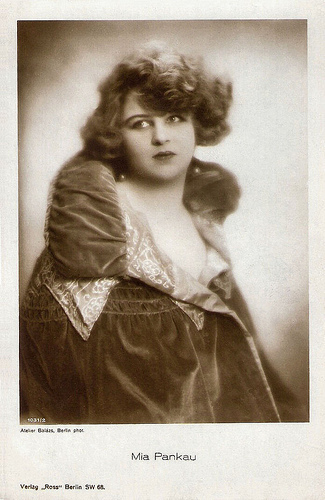
German postcard by Ross Verlag, no. 1031/2, 1927-1928. Photo: Atelier Balázs, Berlin.
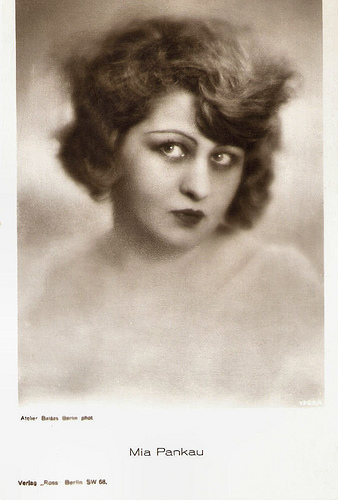
German postcard by Ross Verlag, no. 1755/1, 1927-1928. Photo: Atelier Balázs, Berlin.
When Women Love and Hate
Martha Elisabeth Pankau was born in Friedland, Upper Silesia (now Korfantów in Poland), in 1891.
She made her film debut in 1917 in the film Wenn Frauen lieben und hassen/When Women Love and Hate (1917), directed by Dutch film director Jaap Speyer, with whom she would later marry.
Quite soon she was the leading actress of all of Speyer’s films of the late 1910s. They worked for such companies as Horos Film, Althoff & Co., and the Hamburg based Vera Filmwerke. Their films include Heddas Rache/Hedda's Revenge (1919) with Reinhold Schünzel , Lilli (1919) and the sequel Lilli’s Ehe/Lilli's Marriage (1919).
In the early 1920s followed the two-parter Zügelloses Blut/Unbridled blood (Jaap Speyer, 1920) with Bernhard Goetzke , Entblätterte Blüten/Stripped Blossoms (Jaap Speyer, 1920), Die rote Nacht/The Red Night (Jaap Speyer, 1921) with Oscar Marion , Das blonde Verhängnis/The Blonde Fate (Jaap Speyer, 1921) opposite Ernst Hofmann , Jimmy, ein Schicksal von Mensch und Tier/Jimmy, a destiny of Man and Animal (Jaap Speyer, 1922), and Der allmächtige Dollar/The Almighty Dollar (Jaap Speyer, 1923).
Incidentally she played in films by other directors such as Wolfgang Neff (Der Heiratsschwindler/The marriage swindler, 1922), Leo König (Die Hermannschlacht/The Battle of Hermann, 1924), and Friedrich Zelnik (Briefen die ihn nicht erreichten/Letters He Never Received, 1925).
She continued to work with her husband on the films Elegantes Pack/Elegant stack (Jaap Speyer, 1925), Die Moral der Gasse/The Morals of the Alley (Jaap Speyer, 1925) starring Werner Krauss , Hotelratten/Hotel Rats (Jaap Speyer, 1927) with Nils Asther , and Die drei Frauen der Urban Hell/The Three Wives of Urban Hell (Jaap Speyer, 1928).
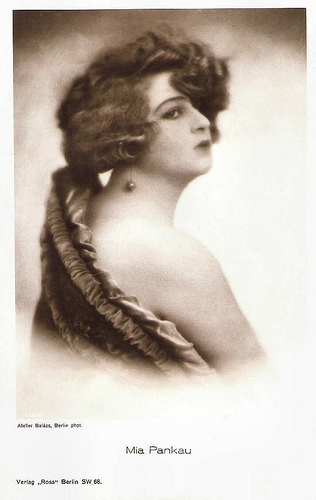
German postcard by Ross Verlag, no. 1031/1, 1927-1928. Photo: Atelier Balázs, Berlin.
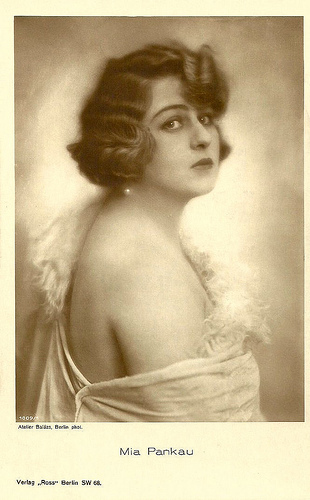
German postcard by Ross Verlag, no. 1009/1, 1927-1928. Photo: Atelier Balázs, Berlin.
White Slave Trade
In the late 1920s, Mia Pankau appeared in supporting parts in such popular productions as Durchlaucht Radieschen/Highness radish (Richard Eichberg, 1927) starring Xenia Desni, and the Anny Ondra vehicle Der erste Kuss/The First Kiss (Carl Lamac, 1929).
Probably her best known is the fantasy/horror film Alraune/A Daughter of Destiny (Henrik Galeen, 1928) featuring Brigitte Helm . Pankau plays a prostitute who is artificially inseminated by a sociopathic scientist ( Paul Wegener ) with the semen of an executed murderer. The result, the angelic Alraune ( Brigitte Helm ) is incapable of feeling any real emotions and kills all the men who fall in love with her.
Pankau easily switched from comedy to drama, from war film to horror film, but she had more difficulty to switch to the sound cinema. She appeared in a short sound film, Besuch um Mitternacht. Nachtgespenst in Berlin/Visit at midnight. The ghost of Berlin (Jaap Speyer, 1930) – a film she had co-produced herself.
After that she performed only in one sound feature: Tänzerinnen für Süd-Amerika gesucht/Girls For Sale (1931), again directed by Speyer. She was clearly not the big star anymore, as the female lead had gone to Dita Parlo . Pankau played a matchmaker involved in white slave trade, Parlo a young victim.
After that Mia Pankau retired from the screen. She died in Hoisdorf near Hamburg, Germany in 1974, at the age of 83.
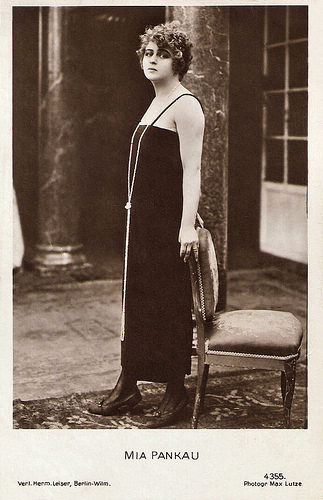
German postcard by Verlag Hermann Leiser, Berlin-Wilm., no. 4355. Photo: Max Lutze.
Alraune (1928). Full film with Italian inter titles. Source: Александр Ющинский (YouTube).
Sources: Thomas Staedeli (Cyranos), Hal Erickson (AllMovie), Filmportal.de, Wikipedia and .

German postcard by Ross Verlag, no. 1031/2, 1927-1928. Photo: Atelier Balázs, Berlin.

German postcard by Ross Verlag, no. 1755/1, 1927-1928. Photo: Atelier Balázs, Berlin.
When Women Love and Hate
Martha Elisabeth Pankau was born in Friedland, Upper Silesia (now Korfantów in Poland), in 1891.
She made her film debut in 1917 in the film Wenn Frauen lieben und hassen/When Women Love and Hate (1917), directed by Dutch film director Jaap Speyer, with whom she would later marry.
Quite soon she was the leading actress of all of Speyer’s films of the late 1910s. They worked for such companies as Horos Film, Althoff & Co., and the Hamburg based Vera Filmwerke. Their films include Heddas Rache/Hedda's Revenge (1919) with Reinhold Schünzel , Lilli (1919) and the sequel Lilli’s Ehe/Lilli's Marriage (1919).
In the early 1920s followed the two-parter Zügelloses Blut/Unbridled blood (Jaap Speyer, 1920) with Bernhard Goetzke , Entblätterte Blüten/Stripped Blossoms (Jaap Speyer, 1920), Die rote Nacht/The Red Night (Jaap Speyer, 1921) with Oscar Marion , Das blonde Verhängnis/The Blonde Fate (Jaap Speyer, 1921) opposite Ernst Hofmann , Jimmy, ein Schicksal von Mensch und Tier/Jimmy, a destiny of Man and Animal (Jaap Speyer, 1922), and Der allmächtige Dollar/The Almighty Dollar (Jaap Speyer, 1923).
Incidentally she played in films by other directors such as Wolfgang Neff (Der Heiratsschwindler/The marriage swindler, 1922), Leo König (Die Hermannschlacht/The Battle of Hermann, 1924), and Friedrich Zelnik (Briefen die ihn nicht erreichten/Letters He Never Received, 1925).
She continued to work with her husband on the films Elegantes Pack/Elegant stack (Jaap Speyer, 1925), Die Moral der Gasse/The Morals of the Alley (Jaap Speyer, 1925) starring Werner Krauss , Hotelratten/Hotel Rats (Jaap Speyer, 1927) with Nils Asther , and Die drei Frauen der Urban Hell/The Three Wives of Urban Hell (Jaap Speyer, 1928).

German postcard by Ross Verlag, no. 1031/1, 1927-1928. Photo: Atelier Balázs, Berlin.

German postcard by Ross Verlag, no. 1009/1, 1927-1928. Photo: Atelier Balázs, Berlin.
White Slave Trade
In the late 1920s, Mia Pankau appeared in supporting parts in such popular productions as Durchlaucht Radieschen/Highness radish (Richard Eichberg, 1927) starring Xenia Desni, and the Anny Ondra vehicle Der erste Kuss/The First Kiss (Carl Lamac, 1929).
Probably her best known is the fantasy/horror film Alraune/A Daughter of Destiny (Henrik Galeen, 1928) featuring Brigitte Helm . Pankau plays a prostitute who is artificially inseminated by a sociopathic scientist ( Paul Wegener ) with the semen of an executed murderer. The result, the angelic Alraune ( Brigitte Helm ) is incapable of feeling any real emotions and kills all the men who fall in love with her.
Pankau easily switched from comedy to drama, from war film to horror film, but she had more difficulty to switch to the sound cinema. She appeared in a short sound film, Besuch um Mitternacht. Nachtgespenst in Berlin/Visit at midnight. The ghost of Berlin (Jaap Speyer, 1930) – a film she had co-produced herself.
After that she performed only in one sound feature: Tänzerinnen für Süd-Amerika gesucht/Girls For Sale (1931), again directed by Speyer. She was clearly not the big star anymore, as the female lead had gone to Dita Parlo . Pankau played a matchmaker involved in white slave trade, Parlo a young victim.
After that Mia Pankau retired from the screen. She died in Hoisdorf near Hamburg, Germany in 1974, at the age of 83.

German postcard by Verlag Hermann Leiser, Berlin-Wilm., no. 4355. Photo: Max Lutze.
Alraune (1928). Full film with Italian inter titles. Source: Александр Ющинский (YouTube).
Sources: Thomas Staedeli (Cyranos), Hal Erickson (AllMovie), Filmportal.de, Wikipedia and .
Published on November 08, 2015 22:00
November 7, 2015
Léon Mathot
Prolific French actor Léon Mathot (1886-1968) became well-known for his role of Edmond Dantès in the French silent serial Le comte de Monte Christo/The Count of Monte Christo (1918). He is also known for his role in two classic silent films by Jean Epstein, Coeur fidèle/The Faithful Heart (1923) and L’Auberge Rouge/The Red Inn (1923). In 1927 he turned director and directed over 20 films in all genres until 1953.
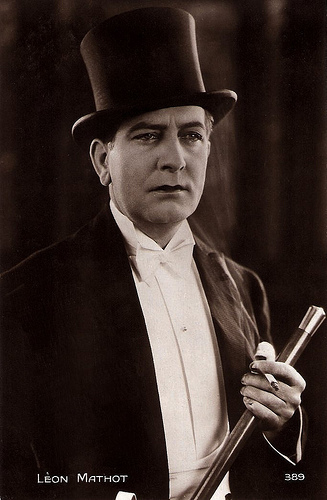
French postcard by Cinémagazine-Edition, Paris, no. 389.
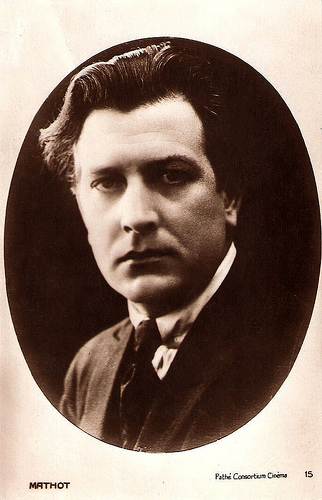
French postcard by Cinémagazine-Edition, no. 15. Photo: Pathé Consortium Cinéma.
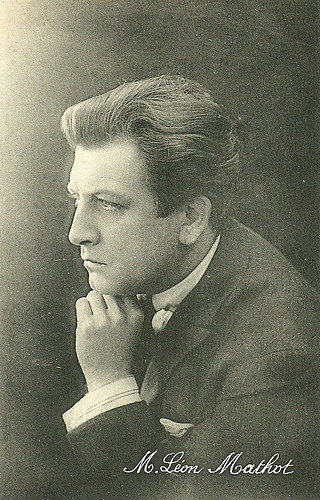
French postcard by M. Le Deley, Paris. Photo: Pathé Consortium Cinéma. Publicity still for L'empereur des pauvres/The Emperor of the poor (René Leprince, 1921).
An Overnight Star
Léon Désiré Joseph Mathot was born in Roubaix, France in 1886. After passing his youth in Liège, Belgium, and following the Conservatory there, he started to play on stage in Lyon, and later in Brussels and Paris.
Thanks to his friend Lucien Nonguet who shot short comedies at Pathé, Mathot started in cinema in 1906 as an extra. His first appearance was in the short and silent André Deed comedy La course à la perruque/The Wig Chase (Georges Hatot, André Heuzé, 1906).
Between 1911 and 1914 he played in dozens of the Gontran comedies, often directed by Lucien Nonguet. He also played in dramatic films by directors Henri Andréani and Alfred Machin, mainly for the Belge-Cinéma. During the First World War Mathot switched to the Film d’Art company, where he worked with the young director Abel Gance , such as in Les gaz mortels/Mortal gases (Abel Gance, 1916).
His collaboration with Henri Pouctal started with the film Volonté/Will (Henri Pouctal, 1917) and culminated in the serial Le comte de Monte Christo/The Count of Monte Christo (Henri Pouctal, 1917-1918), which made Mathot an overnight star. Mathot played Edmond Dantès, the leading character in Alexandre Dumas’ classic novel. Dantès takes revenge on the people who ruined and imprisoned him, after he has come into possession of a huge treasure and a new identity.
This success was followed by other films by Pouctal like Travail/Work (Henri Pouctal, 1919), a film in seven chapters taking place at a steel factory, in which Mathot again had the male lead, opposite Huguette Duflos .
Mathot’s reputation only grew during the 1920s while playing in popular French silent films like L'ami Fritz/The Friend Fritz (René Hervil, 1920) again with Duflos, the serial L'empereur des pauvres/The emperor of the poor (René Leprince, 1922) with Gina Relly , the classic drama Cœur fidèle/The Faithful Heart (Jean Epstein, 1923) with Gina Manès , the Honoré de Balzac adaptation L’Auberge Rouge/The Red Inn (Jean Epstein, 1923) again with Manès, Mon oncle Benjamin/My Uncle Benjamin (René Leprince, 1923), Le puits de Jacob/A Daughter of Israel (Edward José, 1926) with American star Betty Blythe, Le mystère de la Villa Rose/Mystery of the Pink Villa (René Hervil, Louis Mercanton, 1930), and La maison de la flèche/The house of the arrow (Henri Fescourt, 1930) with Annabella .
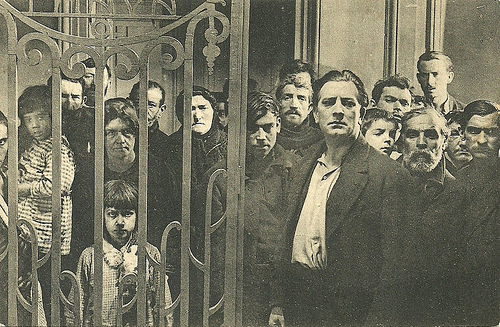
French postcard by M. Le Deley, Paris. Photo: Pathé Consortium Cinéma. Publicity still for L'empereur des pauvres/The Emperor of the poor (René Leprince, 1921). Standing front, Léon Mathot.
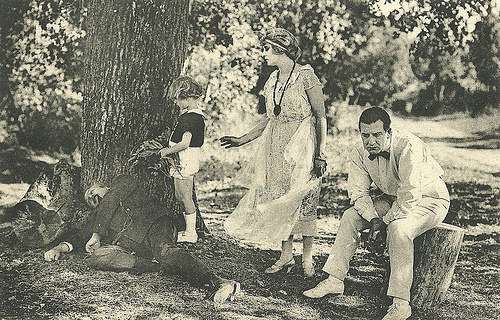
French postcard by M. Le Deley, Paris. Photo: Pathé Consortium Cinéma. Publicity still for L'empereur des pauvres/The Emperor of the poor (René Leprince, 1921). Visible are Gina Relly as Sylvette and Léon Mathot as Marc Anavan.
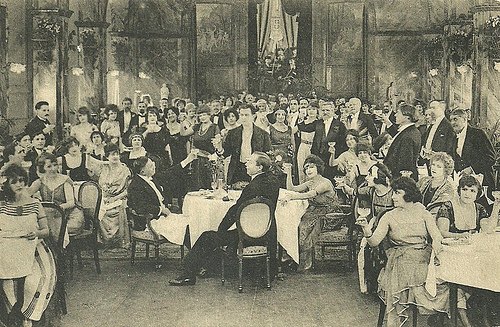
French postcard by M. Le Deley, Paris. Photo: Pathé Consortium Cinéma. Publicity still for L'empereur des pauvres/The Emperor of the poor (René Leprince, 1921). Standing in the middle, Léon Mathot.

French postcard by M. Le Deley, Paris. Photo: Pathé Consortium Cinema. Gina Relly and Léon Mathot in the French silent film L'empereur des pauvres (René Leprince, 1921), an adaptation of the novel by Felicien Champsaur.
Film Direction
When he sensed that his star was descending, Léon Mathot started to combine acting with directing, first with Carmine Gallone Celle qui domine/The one who dominates (Carmine Gallone, Léon Mathot, 1927) and afterwards with André Liabel Dans l’ombre du harem/In the Shadow of the Harem (André Liabel, Léon Mathot, 1928), L’appassionata (André Liabel, Léon Mathot, 1929) with Fernand Fabre and L’instinct/Instinct (André Liabel, Léon Mathot, 1930) with Madeleine Carroll .
When sound cinema became the norm in French cinema, Mathot exclusively focused on film direction. He performed only twice again: in Passeport 13.444/Passport 13444 (1931) which he directed himself, and in Deuxième Bureau contre Kommandantur/Military Intelligence Service against kommandantur (René Jayet, Robert Bibal, 1939), his last role as actor.
In the 1930s he first directed various vehicles for the comic singer Georges Milton such as La bande à Bouboule/Bouboule's Gang (Léon Mathot, 1931) about a carefree Parisian taxi driver, Bouboule 1er roi des nègres/Bouboule the first, king of the negroes (Léon Mathot, 1933), and Le comte Obligado/Count Obligado (Léon Mathot, 1935).
He also directed La Mascotte/The Mascot (Léon Mathot, 1935), an operetta adaptation for the comedian Armand Dranem . He then focused on spy films, and filmed two of the four adventures of Capitaine Benoît based on the novels by Charles-Robert Dumas: Les loups entre eux/Wolves between them (Léon Mathot, 1936) and L’homme à abattre/A Man To Kill (Léon Mathot, 1937).
Mathot then switched again, adapting Gaston Leroux’ Chéri-Bibi (Léon Mathot, 1938), starring Pierre Fresnay . According to Ciné-Ressources , it is one of Mathot’s best films. A year later Mathot also adapted Maurice Larroy’s novel Le révolté/The Rebel (Léon Mathot, 1938), which was scripted by the young Henri-Georges Clouzot.
Former child star René Dary played one of his first serious roles in this film, and four years later, Mathot would direct Dary again in Forte tête/Strong head (Léon Mathot, 1942). After a short return to comedy with Le bois sacré/Sacred Woods (Léon Mathot, 1939) starring Elvire Popesco , Mathot filmed Rappel immédiat/Immediate Call (Léon Mathot, 1939) with Erich von Stroheim and Mireille Balin , a striking spy film.
He also tried his luck with exotic melodrama in Aloha, le chant des ïles/Aloha (Léon Mathot, 1937) starring Arletty, and showed interest in nomads with Cartacalha, reine des gitans/Cartacalha, Queen of the Gypsies (Léon Mathot, 1941) which confirmed the career of Viviane Romance. That same year, the critics appreciated Mathot’s adaptation of Alphonse Daudet’s Fromont jeune et Risler aîné/Fromont junior and Risler senior (Léon Mathot, 1941) with Mireille Balin .
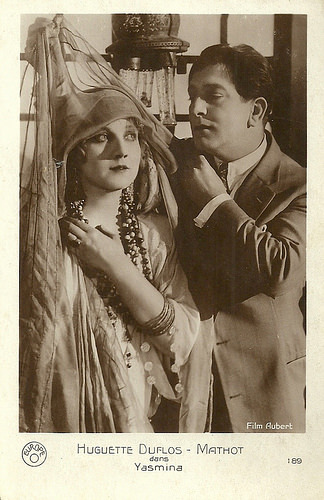
French postcard by Europe, no. 189. Photo: Film Aubert. Publicity still of Huguette Duflos and Léon Mathot in Yasmina (André Hugon, 1927).
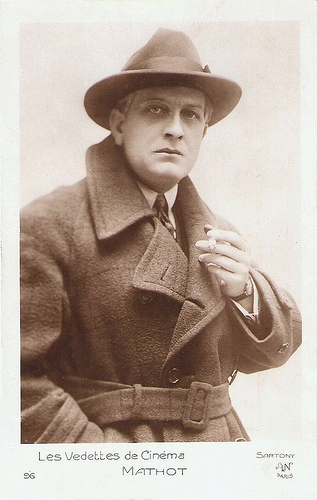
French postcard by A.N., Paris, series Les Vedettes de Cinéma, no. 96. Photo: Sartony.
Film Policier
After the war Léon Mathot alternated melodrama such as La route du bagne/The road to the penal colony (Léon Mathot, 1945) starring Viviane Romance , with ‘film policiers’ like Le dolmen tragique/The tragic dolmen (Léon Mathot, 1948) starring Paulette Dubost , and adventure such as La dernière chevauchée/The last ride (Léon Mathot, 1948) with Mireille Balin and Jacques Dumesnil .
Mathot also shot a pseudo-biography of Marcel Cerdan , L’homme aux mains d’argile/The man in the hands of clay (Léon Mathot, 1949) played by the famous boxer himself.
After having supervised La rue sans loi/The Lawless Street (1950), directed by Marcel Gibaud, Mathot finished his career with a return to comedy: Mon gosse de père/My Childish Father (Léon Mathot, 1953).
Mathot was vice-chair (1938-1959) and later chair of the Cinémathèque française (1959-1967). He was also chairman of the l’Union Européenne des Techniciens du Film et de la Télévision. Léon Mathot died in 1968 in Paris, at the age of 82.
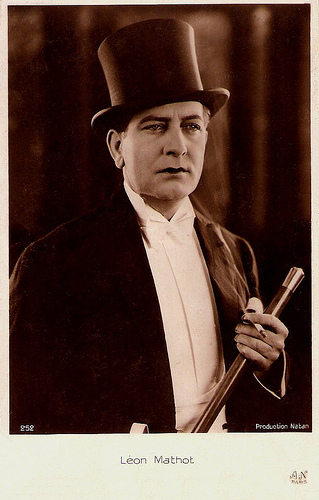
French postcard by A.N., Paris, no. 252. Photo: Production Natan.

Dutch postcard by N.V. De Faam, Breda. Photo: Jacques Haik.
Sources: Jean-Pascal Constantin (Les Gens du Cinéma - French), Ciné-Ressources (French), Wikipedia (French), and .

French postcard by Cinémagazine-Edition, Paris, no. 389.

French postcard by Cinémagazine-Edition, no. 15. Photo: Pathé Consortium Cinéma.

French postcard by M. Le Deley, Paris. Photo: Pathé Consortium Cinéma. Publicity still for L'empereur des pauvres/The Emperor of the poor (René Leprince, 1921).
An Overnight Star
Léon Désiré Joseph Mathot was born in Roubaix, France in 1886. After passing his youth in Liège, Belgium, and following the Conservatory there, he started to play on stage in Lyon, and later in Brussels and Paris.
Thanks to his friend Lucien Nonguet who shot short comedies at Pathé, Mathot started in cinema in 1906 as an extra. His first appearance was in the short and silent André Deed comedy La course à la perruque/The Wig Chase (Georges Hatot, André Heuzé, 1906).
Between 1911 and 1914 he played in dozens of the Gontran comedies, often directed by Lucien Nonguet. He also played in dramatic films by directors Henri Andréani and Alfred Machin, mainly for the Belge-Cinéma. During the First World War Mathot switched to the Film d’Art company, where he worked with the young director Abel Gance , such as in Les gaz mortels/Mortal gases (Abel Gance, 1916).
His collaboration with Henri Pouctal started with the film Volonté/Will (Henri Pouctal, 1917) and culminated in the serial Le comte de Monte Christo/The Count of Monte Christo (Henri Pouctal, 1917-1918), which made Mathot an overnight star. Mathot played Edmond Dantès, the leading character in Alexandre Dumas’ classic novel. Dantès takes revenge on the people who ruined and imprisoned him, after he has come into possession of a huge treasure and a new identity.
This success was followed by other films by Pouctal like Travail/Work (Henri Pouctal, 1919), a film in seven chapters taking place at a steel factory, in which Mathot again had the male lead, opposite Huguette Duflos .
Mathot’s reputation only grew during the 1920s while playing in popular French silent films like L'ami Fritz/The Friend Fritz (René Hervil, 1920) again with Duflos, the serial L'empereur des pauvres/The emperor of the poor (René Leprince, 1922) with Gina Relly , the classic drama Cœur fidèle/The Faithful Heart (Jean Epstein, 1923) with Gina Manès , the Honoré de Balzac adaptation L’Auberge Rouge/The Red Inn (Jean Epstein, 1923) again with Manès, Mon oncle Benjamin/My Uncle Benjamin (René Leprince, 1923), Le puits de Jacob/A Daughter of Israel (Edward José, 1926) with American star Betty Blythe, Le mystère de la Villa Rose/Mystery of the Pink Villa (René Hervil, Louis Mercanton, 1930), and La maison de la flèche/The house of the arrow (Henri Fescourt, 1930) with Annabella .

French postcard by M. Le Deley, Paris. Photo: Pathé Consortium Cinéma. Publicity still for L'empereur des pauvres/The Emperor of the poor (René Leprince, 1921). Standing front, Léon Mathot.

French postcard by M. Le Deley, Paris. Photo: Pathé Consortium Cinéma. Publicity still for L'empereur des pauvres/The Emperor of the poor (René Leprince, 1921). Visible are Gina Relly as Sylvette and Léon Mathot as Marc Anavan.

French postcard by M. Le Deley, Paris. Photo: Pathé Consortium Cinéma. Publicity still for L'empereur des pauvres/The Emperor of the poor (René Leprince, 1921). Standing in the middle, Léon Mathot.

French postcard by M. Le Deley, Paris. Photo: Pathé Consortium Cinema. Gina Relly and Léon Mathot in the French silent film L'empereur des pauvres (René Leprince, 1921), an adaptation of the novel by Felicien Champsaur.
Film Direction
When he sensed that his star was descending, Léon Mathot started to combine acting with directing, first with Carmine Gallone Celle qui domine/The one who dominates (Carmine Gallone, Léon Mathot, 1927) and afterwards with André Liabel Dans l’ombre du harem/In the Shadow of the Harem (André Liabel, Léon Mathot, 1928), L’appassionata (André Liabel, Léon Mathot, 1929) with Fernand Fabre and L’instinct/Instinct (André Liabel, Léon Mathot, 1930) with Madeleine Carroll .
When sound cinema became the norm in French cinema, Mathot exclusively focused on film direction. He performed only twice again: in Passeport 13.444/Passport 13444 (1931) which he directed himself, and in Deuxième Bureau contre Kommandantur/Military Intelligence Service against kommandantur (René Jayet, Robert Bibal, 1939), his last role as actor.
In the 1930s he first directed various vehicles for the comic singer Georges Milton such as La bande à Bouboule/Bouboule's Gang (Léon Mathot, 1931) about a carefree Parisian taxi driver, Bouboule 1er roi des nègres/Bouboule the first, king of the negroes (Léon Mathot, 1933), and Le comte Obligado/Count Obligado (Léon Mathot, 1935).
He also directed La Mascotte/The Mascot (Léon Mathot, 1935), an operetta adaptation for the comedian Armand Dranem . He then focused on spy films, and filmed two of the four adventures of Capitaine Benoît based on the novels by Charles-Robert Dumas: Les loups entre eux/Wolves between them (Léon Mathot, 1936) and L’homme à abattre/A Man To Kill (Léon Mathot, 1937).
Mathot then switched again, adapting Gaston Leroux’ Chéri-Bibi (Léon Mathot, 1938), starring Pierre Fresnay . According to Ciné-Ressources , it is one of Mathot’s best films. A year later Mathot also adapted Maurice Larroy’s novel Le révolté/The Rebel (Léon Mathot, 1938), which was scripted by the young Henri-Georges Clouzot.
Former child star René Dary played one of his first serious roles in this film, and four years later, Mathot would direct Dary again in Forte tête/Strong head (Léon Mathot, 1942). After a short return to comedy with Le bois sacré/Sacred Woods (Léon Mathot, 1939) starring Elvire Popesco , Mathot filmed Rappel immédiat/Immediate Call (Léon Mathot, 1939) with Erich von Stroheim and Mireille Balin , a striking spy film.
He also tried his luck with exotic melodrama in Aloha, le chant des ïles/Aloha (Léon Mathot, 1937) starring Arletty, and showed interest in nomads with Cartacalha, reine des gitans/Cartacalha, Queen of the Gypsies (Léon Mathot, 1941) which confirmed the career of Viviane Romance. That same year, the critics appreciated Mathot’s adaptation of Alphonse Daudet’s Fromont jeune et Risler aîné/Fromont junior and Risler senior (Léon Mathot, 1941) with Mireille Balin .

French postcard by Europe, no. 189. Photo: Film Aubert. Publicity still of Huguette Duflos and Léon Mathot in Yasmina (André Hugon, 1927).

French postcard by A.N., Paris, series Les Vedettes de Cinéma, no. 96. Photo: Sartony.
Film Policier
After the war Léon Mathot alternated melodrama such as La route du bagne/The road to the penal colony (Léon Mathot, 1945) starring Viviane Romance , with ‘film policiers’ like Le dolmen tragique/The tragic dolmen (Léon Mathot, 1948) starring Paulette Dubost , and adventure such as La dernière chevauchée/The last ride (Léon Mathot, 1948) with Mireille Balin and Jacques Dumesnil .
Mathot also shot a pseudo-biography of Marcel Cerdan , L’homme aux mains d’argile/The man in the hands of clay (Léon Mathot, 1949) played by the famous boxer himself.
After having supervised La rue sans loi/The Lawless Street (1950), directed by Marcel Gibaud, Mathot finished his career with a return to comedy: Mon gosse de père/My Childish Father (Léon Mathot, 1953).
Mathot was vice-chair (1938-1959) and later chair of the Cinémathèque française (1959-1967). He was also chairman of the l’Union Européenne des Techniciens du Film et de la Télévision. Léon Mathot died in 1968 in Paris, at the age of 82.

French postcard by A.N., Paris, no. 252. Photo: Production Natan.

Dutch postcard by N.V. De Faam, Breda. Photo: Jacques Haik.
Sources: Jean-Pascal Constantin (Les Gens du Cinéma - French), Ciné-Ressources (French), Wikipedia (French), and .
Published on November 07, 2015 22:00
November 6, 2015
Imported from the USA: Debra Paget
Exotic American actress Debra Paget (1933) is perhaps best known for Cecil B. DeMille's epic The Ten Commandments (1956) and Elvis Presley’s film debut Love Me Tender (1956). Later, she had a career in Europe too. In Germany she starred in Fritz Lang's two-film adventure saga Der Tiger von Eschnapur/The Tiger of Eschnapur (1959) and Das Indische Grabmal/The Indian Tomb (1960) and in Italy she also made a pair of films.
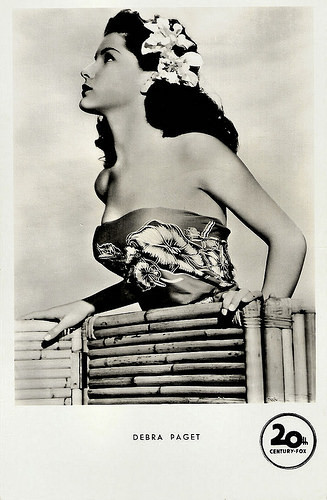
German postcard by Kunst und Bild, Berlin, no. A 240. Photo: 20th Century Fox.
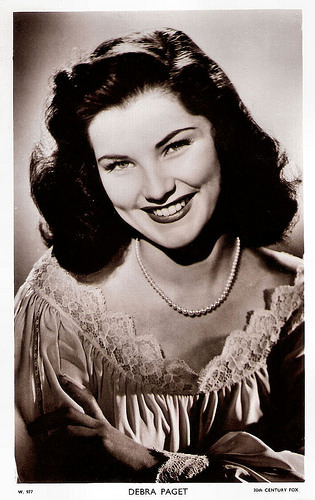
British postcard in the Picturegoer Series, London, no. W 977. Photo: 20th Century Fox.
An Arabian Nights princess
Debra Paget was born as Debralee Griffin in Denver, Colorado, in 1933. She was one of the five children born to former actress Margaret Allen (née Gibson) and painter Frank Henry Griffin.
Hal Erickson at AllMovie : “She may have hailed from Denver, but actress Debra Paget had the sensual, exotic demeanor of an Arabian Nights princess.” And yes, the family moved from Denver to Los Angeles, California, in the 1930s to be close to the developing film industry. Debra was enrolled in the Hollywood Professional School when she was 11.
Stage mother Margaret was determined that Debra and her siblings would also make their careers in show business. And indeed, three of her siblings, Marcia (Teala Loring), Leslie (Lisa Gaye), and Frank (Ruell Shayne), entered show business. Paget had her first professional job at age 8, and acquired some stage experience at 13 when she acted with Charles Coburn in a 1946 production of William Shakespeare's The Merry Wives of Windsor.
Her first notable film role was as Teena Riconti, girlfriend of the character played by Richard Conte, in the Film Noir Cry of the City (Robert Siodmak, 1948). Fresh out of high school in 1949, she acted in three other films before being signed by 20th Century-Fox. Her first vehicle for Fox was the successful Western Broken Arrow (Delmer Daves, 1950) with James Stewart. Paget played an Native American maiden, Sonseeahray (Morningstar), who gives up her life to save Stewart's character.
Paget co-starred with Louis Jourdan in Bird of Paradise (Delmer Daves, 1951), a remake of the 1932 film starring Joel McCrea and Dolores del Rio. It was followed by roles in successful films like the Film Noir Fourteen Hours (Henry Hathaway, 1951), the adventure film Anne of the Indies (Jacques Tourneur, 1951) with Jean Peters and Louis Jourdan , and Prince Valiant (Henry Hathaway, 1954) starring Robert Wagner. Hal Erickson: “Most of her subsequent roles were merely decorative, though she was a more than adequate Cosette in the 1952 version of Les Miserables.”
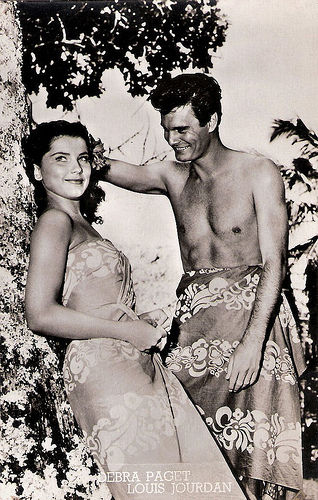
Vintage postcard, no. 552. Photo: 20th Century Fox. Publicity still for Bird of Paradise (Delmer Daves, 1951) with Louis Jourdan .
The most beautiful girl in the world
After the campy costume drama Princess of the Nile (Harmon Jones, 1954) was released, the fan mail Debra Paget received at 20th Century-Fox was topped only by that for Marilyn Monroe and Betty Grable.
The Hollywood studio system dominated American feature film production in the first half of the 20th century. Under it, an actor would sign an exclusive contract to make films for a major studio, such as Fox. The system worked well at first for Paget as her early Fox films did well, so the studio bolstered her film career. In 1955, she broke the exclusivity clause of her contract.
For Fox, she played another Native American girl, Princess Appearing Day, in the Western White Feather (Robert D. Webb, 1955) along with Robert Wagner and Jeffrey Hunter and later at MGM replaced Anne Bancroft as an Indian girl in another Western The Last Hunt (Richard Brooks, 1956), starring Robert Taylor and Stewart Granger.
Then Fox lent her to Paramount for the part of Lilia, the water girl, in Cecil B. DeMille's biblical epic The Ten Commandments (1956), She had to wear brown contact lenses to hide her blue eyes. At the time of its release, it was the most expensive film made. The Ten Commandments (1956) became her most successful film, grossing approximately $122.7 million at the box office during its initial release. It was the most successful film of 1956 and the second-highest grossing film of the decade. In 1957, the film was nominated for seven Academy Awards including Best Picture, winning the Academy Award for Best Visual Effects.
Paget followed it up with Love Me Tender (Robert D. Webb, 1956), the film debut of Elvis Presley. According to Elizabeth Ann at IMDb , Elvis called Debra ‘the most beautiful girl in the world’ but her mother would not allow them to date. The River's Edge (Allan Dwan, 1957) with Anthony Quinn and Ray Milland was the last film she made for Fox. After that, her career began to decline.
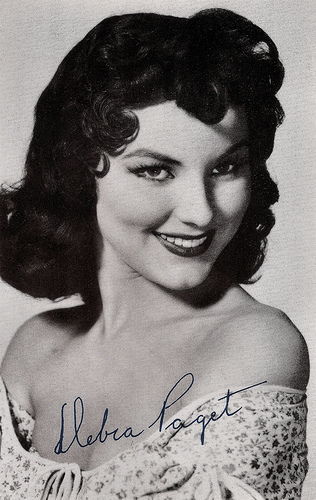
British postcard in the Celebrity Autograph Series, no. 105. Photo: 20th Century Fox. Publicity still for Prince Valiant (Henry Hathaway, 1954).
Her blood pressure-raising belly dance
Debra Paget was typically cast in exotic roles such as South Sea Island maidens or middle-east harem girls. In 1958, she travelled to Germany and India to star opposite Paul Hubschmid and Walter Reyer in Fritz Lang's sumptuous international production Der Tiger von Eschnapur/The Tiger of Eschnapur (1959) and its sequel Das Indische Grabmal/The Indian Tomb (1959). She gained extensive publicity coverage for her blood pressure-raising belly dance in the film.
In 1960 American International Pictures obtained the rights to both films for the USA and combined them into one film called Journey to the Lost City. Tom Wiener at AllMovie : “Contemporary audiences might find Hubschmid and Paget's acting stiff, but psychological nuance is not what Lang was looking for here, and the two do generate genuine sexual chemistry, especially in their flight across the desert which ends this installment.”
In Italy, Paget then appeared in the historical drama Il sepolcro dei re/Cleopatra's Daughter (Fernando Cerchio, 1960) set in Egypt during the reign of the pharaoh Khufu (r. 2589-2566 BC). Wikipedia : “For some reason, the English version was translated very differently from the original Italian script, setting the film in the 1st century BC, rather than the early Bronze Age.”
In the USA, Paget appeared on TV in episodes of the Western series, Riverboat (1959) starring Darren McGavin, Rawhide (1960 and 1962) with Clint Eastwood , and Johnny Ringo (1960). In Italy, she starred in another historical film I Masnadieri/Rome, 1585 (Mario Bonnard, 1961) with Antonio Cifariello.
Her final feature film was the horror film The Haunted Palace (Roger Corman, 1963) with Vincent Price and Lon Chaney Jr. Her last television performance was in an episode of Burke's Law (1965), starring Gene Barry. She retired and later became a born-again Christian. She hosted her own show, An Interlude with Debra Paget on the Trinity Broadcasting Network (TBN), a Christian network, in the early 1990s.
Paget was married three times. First she wed actor and singer David Street in 1958. Their marriage was annulled after four months. In 1960, she married prominent director Budd Boetticher in a Mexican café in Tijuana. He was 44; she was 27. She had acted for him in Seven Men From Now (1955). They separated after just 22 days, and their divorce became official in 1961. In 1962, she married Ling Chiech (Louis) Kung, a Chinese-American oil industry executive and nephew of Madame Chiang Kai-Shek. This third marriage produced a son, Gregory, but ended in divorce in 1980. Gregory would graduate from Texas A&M University and become a lawyer. Today Debra G. Kung lives a quiet life in Houston, Texas.
Trailer Love Me Tender (1956). Source: PickOfTheFlicks Tony (YouTube).
Debra Paget's Snake Dance Scene in Das Indische Grabmal/The Indian Tomb (1959). Source: SnipsOfClips (YouTube).
Trailer The Haunted Palace (1963). Source: Sleaze-O-Rama (YouTube).
Sources: Hal Erickson (AllMovie), Brian G. Walker (Brian's Drive-In Theater), Tom Wiener (AllMovie), (IMDb), Glamour Girls of the Silver Screen, Wikipedia and .

German postcard by Kunst und Bild, Berlin, no. A 240. Photo: 20th Century Fox.

British postcard in the Picturegoer Series, London, no. W 977. Photo: 20th Century Fox.
An Arabian Nights princess
Debra Paget was born as Debralee Griffin in Denver, Colorado, in 1933. She was one of the five children born to former actress Margaret Allen (née Gibson) and painter Frank Henry Griffin.
Hal Erickson at AllMovie : “She may have hailed from Denver, but actress Debra Paget had the sensual, exotic demeanor of an Arabian Nights princess.” And yes, the family moved from Denver to Los Angeles, California, in the 1930s to be close to the developing film industry. Debra was enrolled in the Hollywood Professional School when she was 11.
Stage mother Margaret was determined that Debra and her siblings would also make their careers in show business. And indeed, three of her siblings, Marcia (Teala Loring), Leslie (Lisa Gaye), and Frank (Ruell Shayne), entered show business. Paget had her first professional job at age 8, and acquired some stage experience at 13 when she acted with Charles Coburn in a 1946 production of William Shakespeare's The Merry Wives of Windsor.
Her first notable film role was as Teena Riconti, girlfriend of the character played by Richard Conte, in the Film Noir Cry of the City (Robert Siodmak, 1948). Fresh out of high school in 1949, she acted in three other films before being signed by 20th Century-Fox. Her first vehicle for Fox was the successful Western Broken Arrow (Delmer Daves, 1950) with James Stewart. Paget played an Native American maiden, Sonseeahray (Morningstar), who gives up her life to save Stewart's character.
Paget co-starred with Louis Jourdan in Bird of Paradise (Delmer Daves, 1951), a remake of the 1932 film starring Joel McCrea and Dolores del Rio. It was followed by roles in successful films like the Film Noir Fourteen Hours (Henry Hathaway, 1951), the adventure film Anne of the Indies (Jacques Tourneur, 1951) with Jean Peters and Louis Jourdan , and Prince Valiant (Henry Hathaway, 1954) starring Robert Wagner. Hal Erickson: “Most of her subsequent roles were merely decorative, though she was a more than adequate Cosette in the 1952 version of Les Miserables.”

Vintage postcard, no. 552. Photo: 20th Century Fox. Publicity still for Bird of Paradise (Delmer Daves, 1951) with Louis Jourdan .
The most beautiful girl in the world
After the campy costume drama Princess of the Nile (Harmon Jones, 1954) was released, the fan mail Debra Paget received at 20th Century-Fox was topped only by that for Marilyn Monroe and Betty Grable.
The Hollywood studio system dominated American feature film production in the first half of the 20th century. Under it, an actor would sign an exclusive contract to make films for a major studio, such as Fox. The system worked well at first for Paget as her early Fox films did well, so the studio bolstered her film career. In 1955, she broke the exclusivity clause of her contract.
For Fox, she played another Native American girl, Princess Appearing Day, in the Western White Feather (Robert D. Webb, 1955) along with Robert Wagner and Jeffrey Hunter and later at MGM replaced Anne Bancroft as an Indian girl in another Western The Last Hunt (Richard Brooks, 1956), starring Robert Taylor and Stewart Granger.
Then Fox lent her to Paramount for the part of Lilia, the water girl, in Cecil B. DeMille's biblical epic The Ten Commandments (1956), She had to wear brown contact lenses to hide her blue eyes. At the time of its release, it was the most expensive film made. The Ten Commandments (1956) became her most successful film, grossing approximately $122.7 million at the box office during its initial release. It was the most successful film of 1956 and the second-highest grossing film of the decade. In 1957, the film was nominated for seven Academy Awards including Best Picture, winning the Academy Award for Best Visual Effects.
Paget followed it up with Love Me Tender (Robert D. Webb, 1956), the film debut of Elvis Presley. According to Elizabeth Ann at IMDb , Elvis called Debra ‘the most beautiful girl in the world’ but her mother would not allow them to date. The River's Edge (Allan Dwan, 1957) with Anthony Quinn and Ray Milland was the last film she made for Fox. After that, her career began to decline.

British postcard in the Celebrity Autograph Series, no. 105. Photo: 20th Century Fox. Publicity still for Prince Valiant (Henry Hathaway, 1954).
Her blood pressure-raising belly dance
Debra Paget was typically cast in exotic roles such as South Sea Island maidens or middle-east harem girls. In 1958, she travelled to Germany and India to star opposite Paul Hubschmid and Walter Reyer in Fritz Lang's sumptuous international production Der Tiger von Eschnapur/The Tiger of Eschnapur (1959) and its sequel Das Indische Grabmal/The Indian Tomb (1959). She gained extensive publicity coverage for her blood pressure-raising belly dance in the film.
In 1960 American International Pictures obtained the rights to both films for the USA and combined them into one film called Journey to the Lost City. Tom Wiener at AllMovie : “Contemporary audiences might find Hubschmid and Paget's acting stiff, but psychological nuance is not what Lang was looking for here, and the two do generate genuine sexual chemistry, especially in their flight across the desert which ends this installment.”
In Italy, Paget then appeared in the historical drama Il sepolcro dei re/Cleopatra's Daughter (Fernando Cerchio, 1960) set in Egypt during the reign of the pharaoh Khufu (r. 2589-2566 BC). Wikipedia : “For some reason, the English version was translated very differently from the original Italian script, setting the film in the 1st century BC, rather than the early Bronze Age.”
In the USA, Paget appeared on TV in episodes of the Western series, Riverboat (1959) starring Darren McGavin, Rawhide (1960 and 1962) with Clint Eastwood , and Johnny Ringo (1960). In Italy, she starred in another historical film I Masnadieri/Rome, 1585 (Mario Bonnard, 1961) with Antonio Cifariello.
Her final feature film was the horror film The Haunted Palace (Roger Corman, 1963) with Vincent Price and Lon Chaney Jr. Her last television performance was in an episode of Burke's Law (1965), starring Gene Barry. She retired and later became a born-again Christian. She hosted her own show, An Interlude with Debra Paget on the Trinity Broadcasting Network (TBN), a Christian network, in the early 1990s.
Paget was married three times. First she wed actor and singer David Street in 1958. Their marriage was annulled after four months. In 1960, she married prominent director Budd Boetticher in a Mexican café in Tijuana. He was 44; she was 27. She had acted for him in Seven Men From Now (1955). They separated after just 22 days, and their divorce became official in 1961. In 1962, she married Ling Chiech (Louis) Kung, a Chinese-American oil industry executive and nephew of Madame Chiang Kai-Shek. This third marriage produced a son, Gregory, but ended in divorce in 1980. Gregory would graduate from Texas A&M University and become a lawyer. Today Debra G. Kung lives a quiet life in Houston, Texas.
Trailer Love Me Tender (1956). Source: PickOfTheFlicks Tony (YouTube).
Debra Paget's Snake Dance Scene in Das Indische Grabmal/The Indian Tomb (1959). Source: SnipsOfClips (YouTube).
Trailer The Haunted Palace (1963). Source: Sleaze-O-Rama (YouTube).
Sources: Hal Erickson (AllMovie), Brian G. Walker (Brian's Drive-In Theater), Tom Wiener (AllMovie), (IMDb), Glamour Girls of the Silver Screen, Wikipedia and .
Published on November 06, 2015 22:00
November 5, 2015
EFSP's Dazzling Dozen: Girls Just Want to Have Fun
We continue our new series of a dozen postcards with a theme, especially for Postcard Friendship Friday. Last Friday we had 12 vintage postcards of boy stars, and now of course the floor is to the girls.
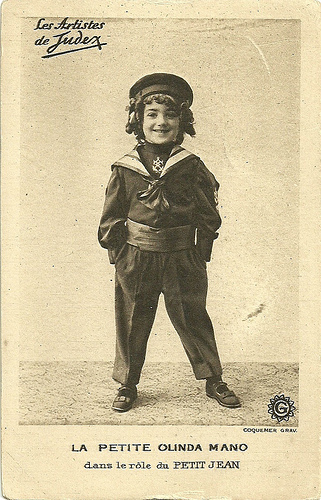
French postcard by Coquemer Gravures, Paris. Photo: Gaumont. Still for La nouvelle mission de Judex (Louis Feuillade 1917-1918).
Olinda Mano (1911-1962) was a child actress in the French silent crime serials by Louis Feuillade. Here as the boy Petit Jean.
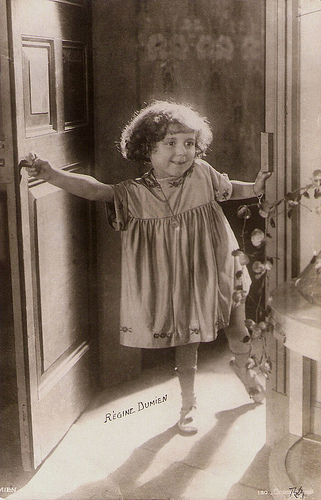
French postcard by Cinémagazine-Edition, no. 130.
Sweet 'little angel' Régine Dumien (1914-1979) was a popular child star of the French silent cinema of the early 1920s.
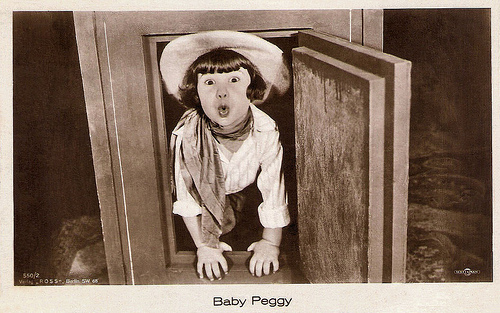
German postcard by Ross Verlag, Berlin, no. 550/2, 1919-1924. Photo: Unifilman.
Diana Serra Cary (1918), best known as Baby Peggy, was one of the three major American child stars of the Hollywood silent movie era along with Jackie Coogan and Baby Marie.
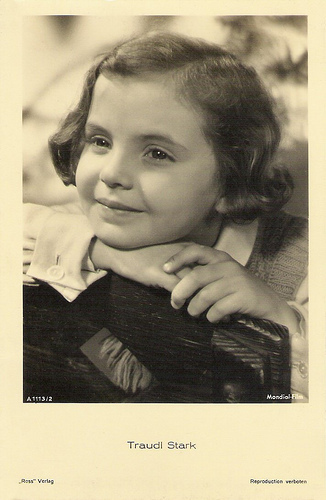
German postcard by Ross Verlag, no. A 1113/2, 1937-1938. Photo: Mondial-Film.
Austrian child actress Traudl Stark (1930) was the Shirley Temple of the German cinema. Between 1935 and 1940 she made a dozen popular films in Austria.
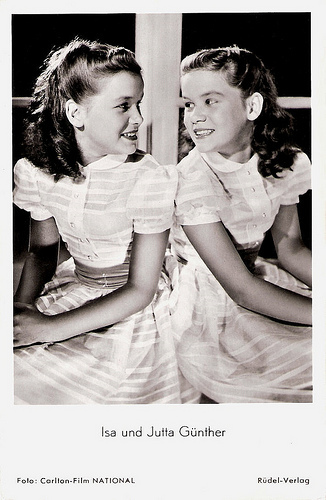
German postcard by Rüdel-Verlag, Hamburg-Bergedorf, no. 533. Photo: Carlton - Film National. Publicity still for Das Doppelte Lottchen/Two Times Lotte (Josef von Baky, 1950).
German twin sisters Isa and Jutta Günther (1938) are former child actresses. In 1950 they were a huge success in the Erich Kästner adaptation Das Doppelte Lottchen/Two Times Lotte. Several more light entertainment films with the twins followed during the 1950s.
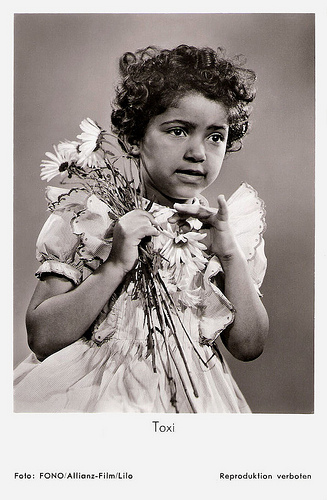
German postcard by Rüdel-Verlag, Hamburg-Bergedorf, no. 395. Photo: Lilo / FONO / Allianz-Film.
Afro-German actress Toxi (1946) starred as a child in a successful drama about racism. As a young adult, she appeared under her real name Elfi Fiegert in a few more films and on TV.
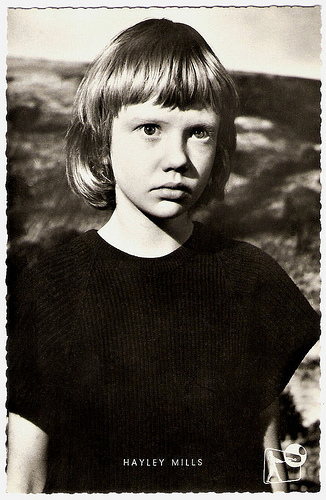
German postcard by Film und Bild, Berlin-Charlottenburg, no. A 1799. Photo: J. Arthur Rank Film.
English actress Hayley Mills (1946) began her acting career as a popular child star and was hailed as a promising newcomer for Tiger Bay (1959), and Pollyanna (1960). During the late 1960s she played in more mature roles. Although she has not maintained the box office success she experienced as a child actress, she has always continued to make films.
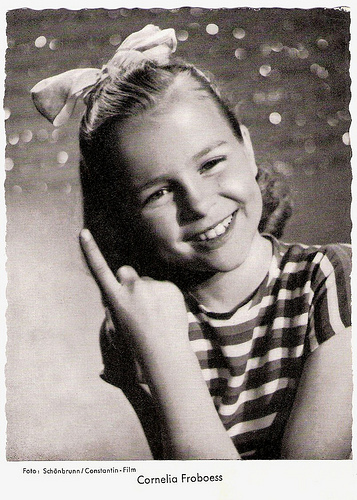
German postcard by WS-Druck, Wanne-Eickel. Photo: Schönbrunn/Constantin-Film.
Conny Froboess (1943) was a teen idol in the late 1950s and early 1960s and would later as Cornelia Froboess become a respected stage actress.
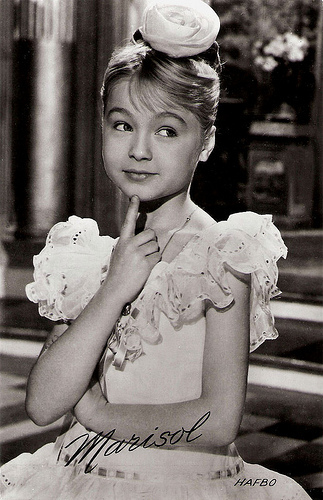
Dutch postcard by Takken, Utrecht, no. 5220. Photo: Hafbo.
Marisol (1948) was a Spanish child star in the sixties. When she became an adult she stayed a popular actress and singer under her real name, Pepa Flores.
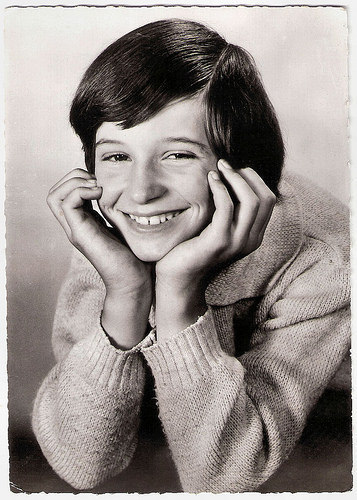
French card. Photo: René Mansat. Publicity still for Zazie dans le métro/Zazie in the Metro (1960).
Catherine Demongeot (1950) made her film debut in the lead role of Zazie dans le metro/Zazie in the Metro (Louis Malle, 1960), based on the novel by Raymond Queneau. She only made two more films. Later on, Demongeot went on to become a teacher.
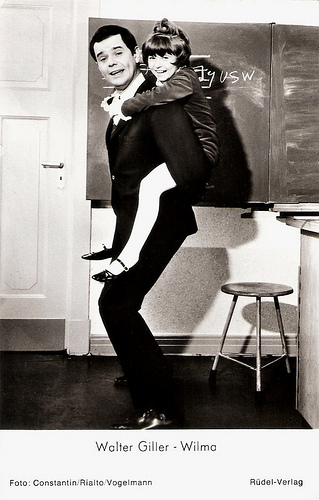
German postcard by Rüdel-Verlag, Hamburg, no. 5009, 1969. Photo: Constantin / Rialto / Vogelmann. Publicity still for Klassenkeile/Spanking at School (Franz Josef Gottlieb, 1969) with Walter Giller and Wilma .
In the late 1960s and the early 1970s, sweet little Wilma (1957) was a popular Dutch child star. At 11, she had hits in both the Netherlands and Germany and also appeared in some Schlager films.
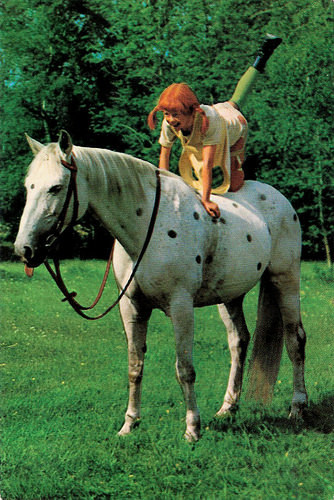
Dutch postcard by Semic International, 1971. Photo: publicity still for Pippi Langstrump/Pippi Longstocking (Olle Hellbom, 1969) starring Inger Nilsson as Pippi Langstrump.
Based on the books by Astrid Lindgren, a hugely popular Pippi Langstrump (Pippi Longstocking) television series was created in Sweden in 1968. Inger Nilsson (1959) gave a confident oddball performance as Pippi. The series, directed by Olle Hellbom, was re-edited as three feature films for the cinema: Pippi Långstrump/Pippi Longstocking (1969), Pippi går ombord/Pippi Goes on Board (1969) and Här kommer Pippi Långstrump/Here Comes Pippi Longstocking (1973). Another two feature film spin-offs were also shown in the cinemas: Pippi Långstrump på de sju haven/Pippi in the South Seas (1970) and På rymmen med Pippi Långstrump/Pippi on the Run (1970). They became weekend television staples throughout the 1970s and 1980s.
This is a post for Postcard Friendship Friday, hosted by Beth at the The Best Hearts are Crunchy. You can visit her by clicking on the button below.


French postcard by Coquemer Gravures, Paris. Photo: Gaumont. Still for La nouvelle mission de Judex (Louis Feuillade 1917-1918).
Olinda Mano (1911-1962) was a child actress in the French silent crime serials by Louis Feuillade. Here as the boy Petit Jean.

French postcard by Cinémagazine-Edition, no. 130.
Sweet 'little angel' Régine Dumien (1914-1979) was a popular child star of the French silent cinema of the early 1920s.

German postcard by Ross Verlag, Berlin, no. 550/2, 1919-1924. Photo: Unifilman.
Diana Serra Cary (1918), best known as Baby Peggy, was one of the three major American child stars of the Hollywood silent movie era along with Jackie Coogan and Baby Marie.

German postcard by Ross Verlag, no. A 1113/2, 1937-1938. Photo: Mondial-Film.
Austrian child actress Traudl Stark (1930) was the Shirley Temple of the German cinema. Between 1935 and 1940 she made a dozen popular films in Austria.

German postcard by Rüdel-Verlag, Hamburg-Bergedorf, no. 533. Photo: Carlton - Film National. Publicity still for Das Doppelte Lottchen/Two Times Lotte (Josef von Baky, 1950).
German twin sisters Isa and Jutta Günther (1938) are former child actresses. In 1950 they were a huge success in the Erich Kästner adaptation Das Doppelte Lottchen/Two Times Lotte. Several more light entertainment films with the twins followed during the 1950s.

German postcard by Rüdel-Verlag, Hamburg-Bergedorf, no. 395. Photo: Lilo / FONO / Allianz-Film.
Afro-German actress Toxi (1946) starred as a child in a successful drama about racism. As a young adult, she appeared under her real name Elfi Fiegert in a few more films and on TV.

German postcard by Film und Bild, Berlin-Charlottenburg, no. A 1799. Photo: J. Arthur Rank Film.
English actress Hayley Mills (1946) began her acting career as a popular child star and was hailed as a promising newcomer for Tiger Bay (1959), and Pollyanna (1960). During the late 1960s she played in more mature roles. Although she has not maintained the box office success she experienced as a child actress, she has always continued to make films.

German postcard by WS-Druck, Wanne-Eickel. Photo: Schönbrunn/Constantin-Film.
Conny Froboess (1943) was a teen idol in the late 1950s and early 1960s and would later as Cornelia Froboess become a respected stage actress.

Dutch postcard by Takken, Utrecht, no. 5220. Photo: Hafbo.
Marisol (1948) was a Spanish child star in the sixties. When she became an adult she stayed a popular actress and singer under her real name, Pepa Flores.

French card. Photo: René Mansat. Publicity still for Zazie dans le métro/Zazie in the Metro (1960).
Catherine Demongeot (1950) made her film debut in the lead role of Zazie dans le metro/Zazie in the Metro (Louis Malle, 1960), based on the novel by Raymond Queneau. She only made two more films. Later on, Demongeot went on to become a teacher.

German postcard by Rüdel-Verlag, Hamburg, no. 5009, 1969. Photo: Constantin / Rialto / Vogelmann. Publicity still for Klassenkeile/Spanking at School (Franz Josef Gottlieb, 1969) with Walter Giller and Wilma .
In the late 1960s and the early 1970s, sweet little Wilma (1957) was a popular Dutch child star. At 11, she had hits in both the Netherlands and Germany and also appeared in some Schlager films.

Dutch postcard by Semic International, 1971. Photo: publicity still for Pippi Langstrump/Pippi Longstocking (Olle Hellbom, 1969) starring Inger Nilsson as Pippi Langstrump.
Based on the books by Astrid Lindgren, a hugely popular Pippi Langstrump (Pippi Longstocking) television series was created in Sweden in 1968. Inger Nilsson (1959) gave a confident oddball performance as Pippi. The series, directed by Olle Hellbom, was re-edited as three feature films for the cinema: Pippi Långstrump/Pippi Longstocking (1969), Pippi går ombord/Pippi Goes on Board (1969) and Här kommer Pippi Långstrump/Here Comes Pippi Longstocking (1973). Another two feature film spin-offs were also shown in the cinemas: Pippi Långstrump på de sju haven/Pippi in the South Seas (1970) and På rymmen med Pippi Långstrump/Pippi on the Run (1970). They became weekend television staples throughout the 1970s and 1980s.
This is a post for Postcard Friendship Friday, hosted by Beth at the The Best Hearts are Crunchy. You can visit her by clicking on the button below.

Published on November 05, 2015 22:00
Paul van Yperen's Blog
- Paul van Yperen's profile
- 13 followers
Paul van Yperen isn't a Goodreads Author
(yet),
but they
do have a blog,
so here are some recent posts imported from
their feed.



